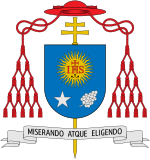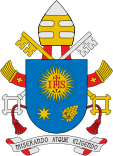Pope Francis
Francis | |||||||||||||||||||||||||
|---|---|---|---|---|---|---|---|---|---|---|---|---|---|---|---|---|---|---|---|---|---|---|---|---|---|
| Bishop of Rome | |||||||||||||||||||||||||
 Pope Francis in 2021 | |||||||||||||||||||||||||
| Church | Catholic Church | ||||||||||||||||||||||||
| Papacy began | 13 March 2013 | ||||||||||||||||||||||||
| Predecessor | Benedict XVI | ||||||||||||||||||||||||
| Previous post(s) |
| ||||||||||||||||||||||||
| Orders | |||||||||||||||||||||||||
| Ordination | 13 December 1969 by Ramón José Castellano | ||||||||||||||||||||||||
| Consecration | 27 June 1992 by Antonio Quarracino | ||||||||||||||||||||||||
| Created cardinal | 21 February 2001 by John Paul II | ||||||||||||||||||||||||
| Personal details | |||||||||||||||||||||||||
| Born | Jorge Mario Bergoglio 17 December 1936 Buenos Aires, Argentina | ||||||||||||||||||||||||
| Nationality | Argentine (with Vatican citizenship) | ||||||||||||||||||||||||
| Denomination | Catholic | ||||||||||||||||||||||||
| Residence | Domus Sanctae Marthae | ||||||||||||||||||||||||
| Education | |||||||||||||||||||||||||
| Motto | Miserando atque eligendo[a] | ||||||||||||||||||||||||
| Signature | |||||||||||||||||||||||||
| Coat of arms |  | ||||||||||||||||||||||||
Ordination history | |||||||||||||||||||||||||
| |||||||||||||||||||||||||
| Part of a series on the |
| Catholic Church |
|---|
 |
| Overview |
| |
Pope Francis (Latin: Franciscus; Italian: Francesco; Spanish: Francisco; born Jorge Mario Bergoglio;[b] 17 December 1936) is head of the Catholic Church and sovereign of the Vatican City State. He is the first pope to be a member of the Society of Jesus (Jesuits), the first from the Americas and the Southern Hemisphere, and the first born or raised outside Europe since the 8th-century papacy of the Syrian pope Gregory III.
Born in Buenos Aires, Argentina, Bergoglio worked for a time as a bouncer and a janitor as a young man before training to be a chemist and working as a technician in a food science laboratory. After recovering from a severe illness of pneumonia and cysts, he was inspired to join the Jesuits in 1958. He was ordained a Catholic priest in 1969, and from 1973 to 1979 was the Jesuit provincial superior in Argentina. He became the archbishop of Buenos Aires in 1998 and was created a cardinal in 2001 by Pope John Paul II. He led the Argentine Church during the December 2001 riots in Argentina. The administrations of Néstor Kirchner and Cristina Fernández de Kirchner considered him to be a political rival.
Following the resignation of Pope Benedict XVI on 28 February 2013, a papal conclave elected Bergoglio as his successor on 13 March. He chose Francis as his papal name in honour of Saint Francis of Assisi. Throughout his public life, Francis has been noted for his humility, emphasis on God's mercy, international visibility as pope, concern for the poor, and commitment to interreligious dialogue. He is credited with having a less formal approach to the papacy than his predecessors, for instance choosing to reside in the Domus Sanctae Marthae guesthouse rather than in the papal apartments of the Apostolic Palace used by previous popes.[2]
Francis has made women full members of dicasteries in the Roman Curia.[3][4] He maintains that the Catholic Church should be more sympathetic toward members of the LGBT community, and has stated that while blessings of same-sex unions are not permitted, the individuals can be blessed, as long as the blessings are not given in a liturgical context.[5] Francis is a critic of unbridled capitalism, consumerism, and overdevelopment;[6] he has made action on climate change a leading focus of his papacy.[7] Widely interpreted as denouncing the death penalty as intrinsically evil,[8] he has termed it "an attack on the inviolability and dignity of the person", "inadmissible", and committed the Church to its abolition,[9] saying that there can be "no going back from this position".[10]
In international diplomacy, Francis has criticized the rise of right-wing populism, called for the decriminalization of homosexuality,[11] helped to restore full diplomatic relations between the United States and Cuba, negotiated a deal with China to define how much influence the Communist Party has in appointing Chinese bishops, and has supported the cause of refugees during the European and Central American migrant crises, calling on the Western World to significantly increase immigration levels.[12][13] In 2022, he apologized for the Church's role in the "cultural genocide" of the Canadian indigenous peoples.[14] On 4 October 2023, Francis convened the beginnings of the Synod on Synodality, described as the culmination of his papacy and the most important event in the Catholic Church since the Second Vatican Council.[4][15][16]
Early years

Pope Francis was born as Jorge Mario Bergoglio on 17 December 1936[17] in Flores,[18] a neighbourhood of Buenos Aires.[17] He was the eldest[19] of five children of Mario José Bergoglio (1908–1959) and Regina María Sívori (1911–1981). Mario Bergoglio was an Italian immigrant accountant[20] born in Portacomaro (Province of Asti) in Italy's Piedmont region. Regina Sívori[21] was a housewife born in Buenos Aires to a family of northern Italian (Piedmontese-Genoese) origin.[22][23][24] Mario José's family left Italy in 1929 to escape the fascist rule of Benito Mussolini.[25] According to María Elena Bergoglio (born 1948), the pope's only living sibling, they did not emigrate for economic reasons.[26] His other siblings were Oscar Adrián (1938–deceased), Marta Regina (1940–2007), and Alberto Horacio (1942–2010).[27][28] Two great-nephews, Antonio and Joseph, died in a traffic collision.[29][30] His niece, Cristina Bergoglio, is a painter based in Madrid, Spain.[31][32]
In the sixth grade, Bergoglio attended Wilfrid Barón de los Santos Ángeles, a school of the Salesians of Don Bosco, in Ramos Mejía, Buenos Aires Province. He attended the technical secondary school Escuela Técnica Industrial Nº 27 Hipólito Yrigoyen,[33] named after a past Argentine president, and graduated with a chemical technician's diploma.[17][34][35] In that capacity, he spent several years working in the food section of Hickethier-Bachmann Laboratory,[36] where he worked under Esther Ballestrino. Earlier, he was a bouncer and a janitor.[37][38]
When he was 21 years old, after life-threatening pneumonia and three cysts, Bergoglio had part of a lung excised.[33][39]
Jesuit (1958–2013)
Bergoglio found his vocation to the priesthood while he was on his way to celebrate the Spring Day. He passed by a church to go to confession, and was inspired by the priest.[40] Bergoglio studied at the archdiocesan seminary, Inmaculada Concepción Seminary, in Villa Devoto, Buenos Aires, and, after three years, entered the Society of Jesus as a novice on 11 March 1958.[41] Bergoglio has said that, as a young seminarian, he had a crush on a girl he met and briefly doubted about continuing the religious career.[42] As a Jesuit novice he studied humanities in Santiago, Chile.[43] After his novitiate in the Society of Jesus, Bergoglio officially became a Jesuit on 12 March 1960, when he made the religious profession of the initial, perpetual vows of poverty, chastity and obedience of a member of the order.[44][45]
In 1960, Bergoglio obtained a licentiate in philosophy from the Colegio Máximo de San José in San Miguel, Buenos Aires Province. He taught literature and psychology at the Colegio de la Inmaculada Concepción, a high school in Santa Fe, from 1964 to 1965. In 1966, he taught the same courses at the Colegio del Salvador in Buenos Aires.[17][46]
Presbyterate (1969–1992)
In 1967 Bergoglio began his theological studies at Facultades de Filosofía y Teología de San Miguel and on 13 December 1969 was ordained to the priesthood by Archbishop Ramón José Castellano. He served as the master of novices for the province there and became a professor of theology.[47]
Bergoglio completed his final stage of spiritual training as a Jesuit, tertianship, at Alcalá de Henares, Spain, and took final, solemn vows as a Jesuit, including the fourth vow of obedience to missioning by the pope, on 22 April 1973.[45] He was named provincial superior of the Society of Jesus in Argentina that July, for a six-year term which ended in 1979.[17][48] In 1973, shortly after being named provincial superior, he had made a pilgrimage to Jerusalem but his stay was shortened by the outbreak of the Yom Kippur War.[49] After the completion of his term of office, in 1980 he was named the rector of the Philosophical and Theological Faculty of San Miguel where he had studied.[50] Before taking up this new appointment, he spent the first three months of 1980 in Ireland to learn English, staying at the Jesuit Centre at the Milltown Institute of Theology and Philosophy, Dublin.[51] He served at San Miguel for six years until 1986[17] when, at the discretion of Jesuit superior-general Peter Hans Kolvenbach, he was replaced by someone more in tune with the worldwide trend in the Society of Jesus toward emphasizing social justice, rather than his emphasis on popular religiosity and direct pastoral work.[52]
He spent several months at the Sankt Georgen Graduate School of Philosophy and Theology in Frankfurt, Germany, considering possible dissertation topics.[53] He settled on exploring the work of the German / Italian theologian Romano Guardini, particularly his study of 'Contrast' published in his 1925 work Der Gegensatz. He returned to Argentina earlier than expected to serve as a confessor and spiritual director to the Jesuit community in Córdoba.[54] It was believed that while in Germany, he saw the painting of Mary, Untier of Knots in Augsburg and brought a copy of the painting to Argentina, but in an interview for the German newsweekly Die Zeit in 2017, Pope Francis stated that he had never been to Augsburg.[55][c] As a student at the Salesian school, Bergoglio was mentored by Ukrainian Greek Catholic priest Stefan Czmil. Bergoglio often rose hours before his classmates to serve Divine Liturgy for Czmil.[58][59]
Bergoglio was asked in 1992 by Jesuit authorities not to reside in Jesuit houses, because of continued tensions with Jesuit leaders and scholars, a sense of Bergoglio's "dissent", views of his Catholic orthodoxy and his opposition to theology of liberation, and his work as auxiliary bishop of Buenos Aires.[60][61][62] As a bishop he was no longer subject to his Jesuit superior.[63] From then on, he did not visit Jesuit houses and was in "virtual estrangement from the Jesuits" until after his election as pope.[52][60]
Pre-papal episcopate (1992–2013)
Bergoglio was named Auxiliary Bishop of Buenos Aires in 1992 and consecrated on 27 June 1992 as titular bishop of Auca,[17][64] with Cardinal Antonio Quarracino, archbishop of Buenos Aires, serving as principal consecrator.[65] He chose as his episcopal motto Miserando atque eligendo.[66] It is drawn from Saint Bede's homily on Matthew 9:9–13: "because he saw him through the eyes of mercy and chose him".[67]
On 3 June 1997, Bergoglio was appointed coadjutor archbishop of Buenos Aires with right of succession. Upon Quarracino's death on 28 February 1998, Bergoglio became metropolitan archbishop of Buenos Aires. In that role, Bergoglio created new parishes and restructured the archdiocese administrative offices, led pro-life initiatives, and created a commission on divorces.[17][68] One of Bergoglio's major initiatives as archbishop was to increase the church's presence in the slums of Buenos Aires. Under his leadership, the number of priests assigned to work in the slums doubled.[69] This work led to him being called the "Slum Bishop".[70]
Early in his time as archbishop of Buenos Aires, Bergoglio sold off the archdiocese's shares in multiple banks and turned its accounts into those of a normal customer in international banks. The shares in banks had led the local church to a propensity toward high spending and the archdiocese was consequently nearly bankrupt. As a normal customer of the bank, the church was forced into a higher fiscal discipline.[71]
On 6 November 1998, while remaining archbishop of Buenos Aires, he was named ordinary for those Eastern Catholics in Argentina who lacked a prelate of their own church.[65] Major Archbishop Sviatoslav Shevchuk said that Bergoglio understands the liturgy, rites, and spirituality of Shevchuk's Ukrainian Greek Catholic Church and always "took care of our Church in Argentina" as ordinary for Eastern Catholics during his time as archbishop of Buenos Aires.[59]
In 2000, Bergoglio was the only church official to reconcile with Jerónimo Podestá, a former bishop who had been suspended as a priest after opposing the Argentine Revolution military dictatorship in 1972. He defended Podestá's wife from Vatican attacks on their marriage.[72][73][74] That same year, Bergoglio said the Argentine Catholic Church needed "to put on garments of public penance for the sins committed during the years of the dictatorship" in the 1970s, during the Dirty War.[75]
Bergoglio made it his custom to celebrate the Holy Thursday ritual washing of feet in places such as jails, hospitals, retirement homes or slums.[76] In 2007, just two days after Benedict XVI issued new rules for using the liturgical forms that preceded the Second Vatican Council, Cardinal Bergoglio established a fixed place for a weekly Mass in this extraordinary form of the Roman Rite.[77] It was celebrated weekly.[78]
On 8 November 2005, Bergoglio was elected president of the Argentine Episcopal Conference for a three-year term (2005–08).[79] He was reelected to another three-year term on 11 November 2008.[80] He remained a member of that commission's permanent governing body, president of its committee for the Pontifical Catholic University of Argentina, and a member of its liturgy committee for the care of shrines.[65] While head of the Argentine Catholic bishops' conference, Bergoglio issued a collective apology for his church's failure to protect people from the Junta during the Dirty War.[81] When he turned 75 in December 2011, Bergoglio submitted his resignation as archbishop of Buenos Aires to Pope Benedict XVI as required by canon law.[49] Still, as he had no coadjutor archbishop, he stayed in office, waiting for an eventual replacement appointed by the Vatican.[82]
Cardinalate (2001–2013)

At the consistory of 21 February 2001, Archbishop Bergoglio was created a cardinal by Pope John Paul II with the title of cardinal priest of San Roberto Bellarmino, a church served by Jesuits and named for one; he was formally installed in that church the following 14 October. When he travelled to Rome for the ceremony, he and his sister María Elena visited the village in northern Italy where their father was born.[26] As cardinal, Bergoglio was appointed to five administrative positions in the Roman Curia. He was a member of the Congregation for Divine Worship and the Discipline of the Sacraments, the Congregation for the Clergy, the Congregation for Institutes of Consecrated Life and Societies of Apostolic Life, the Pontifical Council for the Family and the Commission for Latin America. Later that year, when Cardinal Edward Egan returned to New York following the September 11 attacks, Bergoglio replaced him as relator (recording secretary) in the Synod of Bishops,[83] and, according to the Catholic Herald, created "a favourable impression as a man open to communion and dialogue".[84][85]

Cardinal Bergoglio became known for personal humility, doctrinal conservatism, and a commitment to social justice.[86] A simple lifestyle contributed to his reputation for humility. He lived in a small apartment, rather than in the elegant bishop's residence in the suburb of Olivos. He took public transportation and cooked his own meals.[87] He limited his time in Rome to "lightning visits".[88] He was devoted to St. Thérèse of Lisieux and enclosed a small picture of her in the letters he wrote, calling her "a great missionary saint".[89]
After Pope John Paul II died on 2 April 2005, Bergoglio attended his funeral and was considered one of the papabile for succession to the papacy.[90] He participated as a cardinal elector in the 2005 papal conclave that elected Pope Benedict XVI. In the National Catholic Reporter, John L. Allen Jr. reported that Bergoglio was a frontrunner in the 2005 conclave.[86][91] In September 2005, the Italian magazine Limes published claims that Bergoglio had been the runner-up and main challenger to Cardinal Ratzinger at that conclave and that he had received 40 votes in the third ballot, but fell back to 26 at the fourth and decisive ballot.[92][93] The claims were based on a diary purportedly belonging to an anonymous cardinal who had been present at the conclave.[92][94] According to the Italian journalist Andrea Tornielli, this number of votes had no precedent for a Latin American papabile.[94] La Stampa reported that Bergoglio was in close contention with Ratzinger during the election, until he made an emotional plea that the cardinals should not vote for him.[95] According to Tornielli, Bergoglio made this request to prevent the conclave from delaying too much in the election of a pope.[96]
As a cardinal, Bergoglio was associated with Communion and Liberation, a Catholic evangelical lay movement of the type known as associations of the faithful.[86][97] He sometimes made appearances at the annual gathering known as the Rimini Meeting held during the late summer months in Italy.[86] In 2005, Cardinal Bergoglio authorized the request for beatification—the third step toward sainthood—for six members of the Pallottine community murdered in the San Patricio Church massacre.[98][99] At the same time, Bergoglio ordered an investigation into the murders themselves, which had been widely blamed on the National Reorganization Process, the military junta that ruled Argentina at the time.[99]
Argentine government relations
Dirty War
Bergoglio was the subject of allegations regarding the Argentine Navy's kidnapping of two Jesuit priests, Orlando Yorio and Franz Jalics, in May 1976, during Argentina's Dirty War.[100] He feared for the priests' safety and had tried to change their work prior to their arrest; contrary to reports, he did not try to throw them out of the Jesuit order.[101] In 2005, Myriam Bregman, a human rights lawyer, filed a criminal complaint against Bergoglio, as superior in the Society of Jesus of Argentina, accusing him of involvement in the kidnapping.[102] Her complaint did not specify how Bergoglio was involved; Bergoglio's spokesman flatly denied the allegations. The complaint was ultimately dismissed.[100] The priests were tortured,[103] but were found alive five months later, drugged and semi-naked. Yorio accused Bergoglio of effectively handing them over to the death squads by declining to tell the authorities that he endorsed their work. Yorio, who died in 2000, said in a 1999 interview that he believed that Bergoglio did nothing "to free us, in fact just the opposite".[104] Jalics initially refused to discuss the complaint after moving into seclusion in a German monastery.[105] Two days after the election of Francis, Jalics issued a statement confirming the kidnapping and attributing the cause to a former lay colleague who became a guerrilla, was captured, then named Yorio and Jalics when interrogated.[106] The following week, Jalics issued a second, clarifying statement: "It is wrong to assert that our capture took place at the initiative of Father Bergoglio (…) the fact is, Orlando Yorio and I were not denounced by Father Bergoglio."[107][108]
Bergoglio told his authorized biographer, Sergio Rubin, that after the priests' imprisonment, he worked behind the scenes for their release; Bergoglio's intercession with dictator Jorge Rafael Videla on their behalf may have saved their lives.[109] Bergoglio also told Rubin that he had often sheltered people from the dictatorship on church property, and once gave his own identity papers to a man who looked like him, so he could flee Argentina.[103] The interview with Rubin, reflected in the biography El jesuita, is the only time Bergoglio has spoken to the press about those events.[110] Alicia Oliveira, a former Argentine judge, has also reported that Bergoglio helped people flee Argentina during the rule of the junta.[111] Since Francis became pope, Gonzalo Mosca[112] and José Caravias[113] have related to journalists accounts of how Bergoglio helped them flee the Argentine dictatorship.
Oliveira described the future pope as "anguished" and "very critical of the dictatorship" during the Dirty War.[114] Oliveira met with him at the time and urged Bergoglio to speak out—he told her that "he couldn't. That it wasn't an easy thing to do."[104] Artist and human rights activist Adolfo Pérez Esquivel, the 1980 Nobel Peace Prize laureate, said: "Perhaps he didn't have the courage of other priests, but he never collaborated with the dictatorship. … Bergoglio was no accomplice of the dictatorship."[115][116] Graciela Fernández Meijide, member of the Permanent Assembly for Human Rights, also said that there was no proof linking Bergoglio with the dictatorship. She told the Clarín newspaper: "There is no information and Justice couldn't prove it. I was in the APDH during all the dictatorship years and I received hundreds of testimonies. Bergoglio was never mentioned. It was the same in the CONADEP. Nobody mentioned him as instigator or as anything."[117] Ricardo Lorenzetti, President of the Argentine Supreme Court, also has said that Bergoglio is "completely innocent" of the accusations.[118] Historian Uki Goñi pointed that, during early 1976, the military junta still had a good image among society, and that the scale of the political repression was not known until much later; Bergoglio would have had little reason to suspect that the detention of Yorio and Jalics could end up in their deaths.[119]
When Bergoglio became pope, an alleged photo of him giving the sacramental bread to dictator Jorge Rafael Videla became popular in social networks. It has also been used by the newspaper Página/12.[120] The photo was soon proved to be false. It was revealed that the priest, whose face is not visible in the photo, was Carlos Berón de Astrada. The photo was taken at the church "Pequeña Obra de la Divina Providencia Don Orione" in 1990, not during the Dirty War, and after Videla's presidential pardon. The photo was produced by the agency AFP and it was initially published by the Crónica newspaper.[121]
Fernando de la Rúa
Fernando de la Rúa replaced Carlos Menem as president of Argentina in 1999. As an archbishop, Bergoglio celebrated the annual Mass at the Buenos Aires Metropolitan Cathedral on the First National Government holiday, 25 May. In 2000, Bergoglio criticized the perceived apathy of society.[122] Argentina faced an economic depression at the time, and the Catholic Church criticized the fiscal austerity of the government, which increased poverty. De la Rúa asked the church to promote a dialogue between the leaders of economic and political sectors to find a solution for the crisis. He claims that he talked with Bergoglio and proposed to take part in the meeting, but Bergoglio would have told him that the meeting was cancelled because of a misunderstanding by De la Rúa's assistant, who may have declined the president's assistance. Bishop Jorge Casaretto considers it unlikely, as De la Rúa only made the request in newspaper interviews, but never made a formal request to the church.[123]
The Justicialist Party won the 2001 elections and got the majority in the Congress, and appointed Ramón Puerta as president of the Senate. As vice-president Carlos Álvarez resigned shortly before, this left an opposing party second in the order of precedence. Bergoglio asked for an interview with Puerta, and had a positive impression of him. Puerta told him that the Justicialist party was not plotting to oust De la Rúa, and promised to help the president promote the laws that may be required.[124]
During police repression of the riots of December 2001, he contacted the Ministry of the Interior and asked that the police distinguish rioters and vandals from peaceful protesters.[125]
Néstor and Cristina Kirchner

When Bergoglio celebrated Mass at the cathedral for the 2004 First National Government holiday, President Néstor Kirchner attended and heard Bergoglio request more political dialogue, reject intolerance, and criticize exhibitionism and strident announcements.[126] Kirchner celebrated the national day elsewhere the following year and the Mass in the cathedral was suspended.[127] In 2006, Bergoglio helped the fellow Jesuit Joaquín Piña to win the elections in the Misiones Province and prevent an amendment of the local constitution that would allow indefinite re-elections. Kirchner intended to use that project to start similar amendments at other provinces, and eventually to the national constitution.[128] Kirchner considered Bergoglio as a political rival to the day he died in October 2010.[129] Bergoglio's relations with Kirchner's widow and successor, Cristina Fernández de Kirchner, have been similarly tense. In 2008, Bergoglio called for national reconciliation during disturbances in the country's agricultural regions, which the government interpreted as a support for anti-government demonstrators.[129] The campaign to enact same-sex marriage legislation was a particularly tense period in their relations.[129]
When Bergoglio was elected pope, the initial reactions were mixed. Most of the Argentine society cheered it, but the pro-government newspaper Página/12 published renewed allegations about the Dirty War, and the president of the National Library described a global conspiracy theory. The president took more than an hour before congratulating the new pope, and only did so in a passing reference within a routine speech. Due to the pope's popularity in Argentina, Cristina Kirchner made what the political analyst Claudio Fantini called a "Copernican shift" in her relations with him and fully embraced the Francis phenomenon.[130] On the day before his inauguration as pope, Bergoglio, now Francis, had a private meeting with Kirchner. They exchanged gifts and lunched together. This was the new pope's first meeting with a head of state, and there was speculation that the two were mending their relations.[131][132] Página/12 removed their controversial articles about Bergoglio, written by Horacio Verbitsky, from their web page, as a result of this change.[133]
Javier Milei
Before Javier Milei's election to the Argentine presidency, he was very critical of Francis, describing him as "imbecile" and a "communist turd". His disparaging comments sparked controversy among Catholics.[134] However, following his inauguration, Milei softened his position and formally invited Francis to Argentina. Milei visited the Vatican on 11 February 2024, the day Francis canonized María Antonia de Paz y Figueroa, the first female Argentine saint.[135]
Papacy (2013–present)
Elected at 76 years old, Francis was reported to be healthy and his doctors have said his missing lung tissue, removed in his youth, does not significantly affect his health.[139] The only concern would be decreased respiratory reserve if he had a respiratory infection.[140] In the past, one attack of sciatica in 2007 prevented him from attending a consistory and delayed his return to Argentina for several days.[88]
Francis is the first Jesuit pope. This was a significant appointment, because of the sometimes tense relations between the Society of Jesus and the Holy See.[141] He came in second to Cardinal Ratzinger on all the ballots in the 2005 conclave and at the time appeared as the only other viable candidate.[142] He is also the first from the Americas,[143] and the first from the Southern Hemisphere.[144] Many media reported him as being the first non-European pope, but he is actually the 11th; the previous was Gregory III from Syria, who died in 741. Moreover, although Francis was not born in Europe, he is ethnically European; his father and maternal grandparents are from northern Italy.[145]
As pope, his manner is less formal than that of his immediate predecessors: a style that news coverage has referred to as "no frills", noting that it is "his common touch and accessibility that is proving the greatest inspiration".[146] On the night of his election, he took a bus back to his hotel with the cardinals, rather than be driven in the papal car.[147] The next day, he visited Cardinal Jorge María Mejía in the hospital and chatted with patients and staff.[148] At his first media audience, the Saturday after his election, the pope explained his papal name choice, citing Saint Francis of Assisi as "the man who gives us this spirit of peace, the poor man", and he added "[h]ow I would like a poor Church, and for the poor".[149]
In addition to his native Spanish, he speaks fluent Italian (the official language of Vatican City and the "everyday language" of the Holy See) and German. He is also conversant in Latin (the official language of the Holy See),[150] French,[151] Portuguese,[152] and English,[153][154] and he understands the Piedmontese language and some Genoese.[155]
Francis chose not to live in the official papal residence in the Apostolic Palace, but to remain in the Vatican guest house, in a suite in which he can receive visitors and hold meetings. He is the first pope since Pope Pius X to live outside the papal apartments.[156] Francis still appears at the window of the Apostolic Palace for the Sunday Angelus.[157]
As a Jesuit pope, he has been "making clear that a fundamental task of the faithful is not so much to follow rules but to discern what God is calling them to do. He is altering the culture of the clergy, steering away from what he has named as "clericalism" (which dwells on priestly status and authority) and toward an ethic of service (Francis says the church's shepherds must have the "smell of the sheep", always staying close to the People of God)."[158]
On 13 December 2023, in an interview with Mexican broadcaster Televisa, Francis said that his "great devotion" was to the Salus populi Romani icon at the Santa Maria Maggiore in Rome. Francis also told the news outlet that his tomb was already prepared at the basilica near the icon. Francis will be the first pope since Pope Leo XIII to be buried outside the Vatican.[159]
Election

Bergoglio was elected pope on 13 March 2013,[17][160][161] the second day of the 2013 papal conclave, taking the papal name Francis.[17][162] Francis was elected on the fifth ballot of the conclave.[163] The Habemus papam announcement was delivered by the cardinal protodeacon, Jean-Louis Tauran.[164] Cardinal Christoph Schönborn later said that Bergoglio was elected following two supernatural signs, one in the conclave - and hence confidential - and a Latin-American couple, friends of Schönborn at Vatican City, who whispered Bergoglio's name in the elector's ear; Schönborn commented "if these people say Bergoglio, that's an indication of the Holy Spirit".[165]
Instead of accepting his cardinals' congratulations while seated on the papal throne, Francis received them standing, reportedly an immediate sign of a changing approach to formalities at the Vatican.[166] During his first appearance as pontiff on the balcony of Saint Peter's Basilica, he wore a white cassock, not the red, ermine-trimmed mozzetta[166][167] used by previous popes.[168] He also wore the same iron pectoral cross that he had worn as archbishop of Buenos Aires, rather than the gold one worn by his predecessors.[167]
After being elected and choosing his name, his first act was bestowing the Urbi et Orbi blessing on thousands of pilgrims gathered in St. Peter's Square. Before blessing the crowd, he asked those in St. Peter's Square to pray for his predecessor, "the bishop emeritus of Rome" Pope Benedict XVI, and for himself as the new "bishop of Rome".[169]
Francis held his papal inauguration on 19 March 2013 in St. Peter's Square in the Vatican.[17] He celebrated Mass in the presence of various political and religious leaders from around the world.[170] In his homily Francis focused on the Solemnity of Saint Joseph, the liturgical day on which the Mass was celebrated.[171]
Name
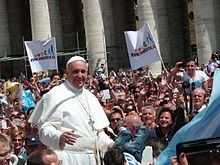
At his first audience on 16 March 2013, Francis told journalists that he had chosen the name in honour of Saint Francis of Assisi, and had done so because he was especially concerned for the well-being of the poor.[172][173][174] He explained that, as it was becoming clear during the conclave voting that he would be elected the new bishop of Rome, the Brazilian Cardinal Cláudio Hummes had embraced him and whispered, "Don't forget the poor", which had made Bergoglio think of the saint.[175][176] Bergoglio had previously expressed his admiration for St. Francis, explaining that: "He brought to Christianity an idea of poverty against the luxury, pride, vanity of the civil and ecclesiastical powers of the time. He changed history."[177]
This is the first time that a pope has been named Francis. On the day of his election, the Vatican clarified that his official papal name was "Francis", not "Francis I", i.e. no regnal number is used for him. A Vatican spokesman said that the name would become Francis I if and when there is a Francis II.[173][178] It is the first time since Lando's 913–914 pontificate that a serving pope holds a name not used by a predecessor.[d]
Francis also said that some cardinal electors had jokingly suggested to him that he should choose either "Adrian", since Adrian VI had been a reformer of the church, or "Clement" to settle the score with Clement XIV, who had suppressed the Jesuit order.[149][180] In February 2014, it was reported that Bergoglio, had he been elected in 2005, would have chosen the pontifical name of "John XXIV" in honour of John XXIII. It was said that he told Cardinal Francesco Marchisano: "John, I would have called myself John, like the Good Pope; I would have been completely inspired by him".[181]
Curia
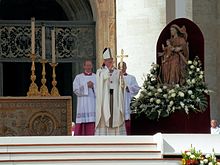
On 16 March 2013, Francis asked all those in senior positions of the Roman Curia to provisionally continue in office.[182] He named Alfred Xuereb as his personal secretary.[183] On 6 April he named José Rodríguez Carballo as secretary for the Congregation for Institutes of Consecrated Life and Societies of Apostolic Life, a position that had been vacant for several months.[184] Francis abolished the bonuses paid to Vatican employees upon the election of a new pope, amounting to several million Euros, opting instead to donate the money to charity.[185] He also abolished the €25,000 annual bonus paid to the cardinals serving on the Board of Supervisors for the Vatican bank.[186]
On 13 April 2013, he named eight cardinals to a new Council of Cardinal Advisers to advise him on revising the organizational structure of the Roman Curia. The group included several known as critics of Vatican operations and only one member of the Curia.[187] They are Giuseppe Bertello, president of the Vatican City State governorate; Francisco Javier Errazuriz Ossa from Chile; Oswald Gracias from India; Reinhard Marx from Germany; Laurent Monsengwo Pasinya from the Democratic Republic of the Congo; George Pell from Australia; Seán O'Malley from the United States; and Óscar Andrés Rodríguez Maradiaga from Honduras. He appointed Bishop Marcello Semeraro secretary for the group and scheduled its first meeting for 1–3 October.[188]
Early issues
In March 2013, 21 British Catholic peers and members of Parliament from all parties asked Francis to allow married men in Great Britain to be ordained as priests, keeping celibacy as the rule for bishops. They asked it on the grounds that it would be anomalous that married Anglican priests can be received into the Catholic Church and ordained as priests, by means of either the Pastoral Provision of 20 June 1980 or the 2009 Anglican ordinariate, but married Catholic men cannot do the same.[189]
Fouad Twal, the Latin patriarch of Jerusalem, included a call in his 2013 Easter homily for the pope to visit Jerusalem.[190] Louis Raphael I, the Chaldean Catholic Patriarch, asked the pope to visit the "embattled Christian community" in Iraq.[191] In March 2021, Pope Francis went to Iraq on a first-ever papal visit to the diminishing Christian communities of Mesopotamia fallen apart after years of conflict.[192]
On the first Holy Thursday following his election, Francis washed and kissed the feet of ten male and two female juvenile offenders, not all Catholic, aged from 14 to 21, imprisoned at Rome's Casal del Marmo detention facility, telling them the ritual of foot washing is a sign that he is at their service.[193] This was the first time that a pope had included women in this ritual; although he had already done so when he was archbishop.[193] One of the male and one of the female prisoners were Muslim.[193]
On 31 March 2013, Francis used his first Easter homily to make a plea for peace throughout the world, specifically mentioning the Middle East, Africa, and North and South Korea.[194] He also spoke out against those who give in to "easy gain" in a world filled with greed, and made a plea for humanity to become a better guardian of creation by protecting the environment.[194] He said that "[w]e ask the risen Jesus, who turns death into life, to change hatred into love, vengeance into forgiveness, war into peace."[195] In 2019 he stated that ecocide was a sin and should be made "a fifth category of crimes against peace, which should be recognised as such by the international community".[196][197][198]
Although the Vatican had prepared greetings in 65 languages, Francis chose not to read them.[154] According to the Vatican, the pope "at least for now, feels at ease using Italian, the everyday language of the Holy See".[199]
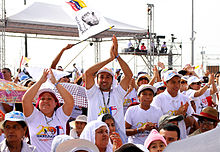
In 2013, Francis initially reaffirmed the Congregation for the Doctrine of the Faith's program to reform the U.S. Leadership Conference of Women Religious,[200] initiated under his predecessor, Pope Benedict XVI. The New York Times reported that the Vatican had formed the opinion in 2012 that the sisters' group was tinged with feminist influences, focused too much on ending social and economic injustice and not enough on stopping abortion, and permitted speakers at its meetings who questioned church doctrine.[201][202] In April 2015 the investigation was brought to a close. While the timing of the closure may have anticipated a visit by Francis to the U.S. in September 2015, it was noted that the sisters' emphasis is close to that of Francis.[203]
On 12 May, Francis carried out his first canonizations of candidates approved for sainthood during the reign of Benedict XVI: the first Colombian saint, Laura of Saint Catherine of Siena, the second female Mexican saint, María Guadalupe García Zavala, both of the 20th century, and the 813 15th-century Martyrs of Otranto. He said: "While we venerate the martyrs of Otranto, ask God to support the many Christians who still suffer from violence and give them the courage and fate and respond to evil with goodness."[204]
Synodal church
Francis has overseen synods on the family (2014), on youth (2018), and on the church in the Amazon region (2019). In 2019 Francis's apostolic constitution Episcopalis communio allowed that the final document of a synod may become magisterial teaching simply with papal approval. The constitution also allowed for laity to contribute input directly to the synod's secretary general.[205] Some analysts see the creation of a truly synodal church as likely to become the greatest contribution of Francis's papacy.[206]
On 4 October 2023, Francis convened the beginnings of the Synod on Synodality (the Sixteenth Ordinary General Assembly of the Synod of Bishops). This synod is described as the culmination of his papacy and the most important event in the Church since the Second Vatican Council.[15][16]
Consultation with Catholic laity
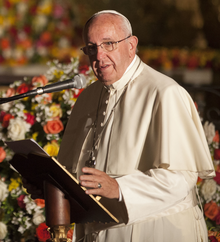
A February 2014 survey by the World Values Survey cited in The Washington Post and Time shows how the unity Francis had created could be challenged. Although views about Francis personally were favourable, many Catholics disagreed with at least some of his teachings. The survey found that members of the Catholic Church are deeply divided over abortion, artificial contraception, divorce, the ordination of women, and married priests.[207][208] In the same month Francis asked parishes to provide answers to an official questionnaire[209] described as a "much broader consultation than just a survey"[210] regarding opinions among the laity. He continued to assert Catholic doctrine, in less dramatic tone than his recent predecessors, who maintained that the Catholic Church is not a democracy of popular opinion.[211]
Linda Woodhead of Lancaster University wrote of the survey Francis initiated, "it's not a survey in any sense that a social scientist would recognize". Woodhead said that many ordinary Catholics would have difficulty understanding theological jargon there. Nonetheless, she suspected the survey might be influential.[212]
The Catholic Church in England and Wales as of April 2014[update] had refused to publish results of this survey; a church spokesman said a senior Vatican official had expressly asked for summaries to remain confidential, and that orders had come from the pope that the information should not be made public until after October. This disappointed many reformers who hoped the laity would be more involved in decision-making. Some other Catholic churches, for example in Germany and Austria, published summaries of the responses to the survey, which showed a wide gap between church teaching and the behaviour of ordinary Catholics.[210]
In a column he wrote for the Vatican's semi-official newspaper L'Osservatore Romano, the then-Prefect of the Supreme Tribunal of the Apostolic Signatura, American cardinal Raymond Leo Burke, who has a long-standing reputation as one of the church's most vocal conservative hard-liners, said that Francis opposed both abortion and gay marriage.[213] The Vatican's chief spokesman, Father Federico Lombardi, also noted in the Vatican press office during the 2014 consistory meetings that Francis and Cardinal Walter Kasper would not change or redefine any dogmas pertaining to church theology on doctrinal matters.[214]
Institute for the Works of Religion
In the first months of Francis's papacy, the Institute for the Works of Religion, informally known as the Vatican Bank, said that it would become more transparent in its financial dealings[215] There had long been allegations of corruption and money laundering connected with the bank.[216][217] Francis appointed a commission to advise him about reform of the Bank,[216][217] and the finance consulting firm Promontory Financial Group was assigned to carry out a comprehensive investigation of all customer contacts of the bank on these facts.[218] Because of this affair the Promoter of Justice at the Vatican Tribunal applied a letter rogatory for the first time in the history of the Republic of Italy at the beginning of August 2013.[219] In January 2014, Francis replaced four of the five cardinal overseers of the Vatican Bank, who had been confirmed in their positions in the final days of Benedict XVI's papacy.[220] Lay experts and clerics were looking into how the bank was run. Ernst von Freyberg was put in charge. Moneyval feels more reform is needed, and Francis may be willing to close the bank if the reforms prove too difficult.[221] There is uncertainty how far reforms can succeed.[222]
Papal documents
On 29 June 2013, Francis published the encyclical Lumen fidei, which was largely the work of Benedict XVI but awaiting a final draft at his retirement.[223] On 24 November 2013, Francis published his first major letter as pope, the apostolic exhortation Evangelii gaudium,[224] which he described as the programmatic of his papacy.[225] On 18 June 2015, he published his first own, original encyclical Laudato si' concerning care for the planet.[226] On 8 April 2016, Francis published his second apostolic exhortation, Amoris laetitia,[227] remarking on love within the family. Controversy arose at the end of 2016 when four cardinals formally asked Francis for clarifications, particularly on the issue of giving communion to divorced and civilly remarried Catholics.[228]
His motu proprios include Ai nostri tempi and De concordia inter codices. Francis issued another titled Maiorem hac dilectionem which created a new path toward canonization for certain causes.
Francis established two new Secretariats (top-level departments) in the Roman Curia: the Secretariat for the Economy, and the Secretariat for Communications. He simplified the process for declaring matrimonial nullity.[229]
On 8 December 2017, Francis signed a new apostolic constitution on ecclesiastical universities and faculties Veritatis gaudium, published 29 January 2018.[230]
A further Apostolic Exhortation, Gaudete et exsultate (Rejoice and be glad), was published on 19 March 2018, dealing with "the call to holiness in today's world" for all persons. He counters contemporary versions of the gnostic and Pelagian heresies and describes how Jesus's beatitudes call people to "go against the flow".[231]
In February 2019, Francis acknowledged that priests and bishops were sexually abusing religious sisters.[232] He addressed this and the clergy sex abuse scandal by convening a summit on clergy sexual abuse in Rome 21–24 February 2019.[233] As a follow-up to that summit, on 9 May 2019 Francis promulgated the motu proprio Vos estis lux mundi which specified responsibilities, including reporting directly to the Holy See on bishops and on one's superior, while simultaneously involving another bishop in the archdiocese of the accused bishop.[234]
On 30 September 2020, he published the apostolic letter Scripturae sacrae affectus to celebrate the 16th centenary of the death of Jerome.[235][236]
On 4 October 2020 on the feast of St. Francis of Assisi, Francis published the encyclical Fratelli tutti on fraternity and social friendship, using St. Francis's own words to describe our universal brotherhood and sisterhood.[237]
On 8 December 2020 on the Feast of the Immaculate Conception, Pope Francis published the apostolic letter Patris corde ("With a Father's Heart").[238] To mark the occasion, the Pope proclaimed a "Year of Saint Joseph" from 8 December 2020, to 8 December 2021 on the 150th Anniversary of the Proclamation of Saint Joseph as Patron of the Universal Church.[239]
On 1 June 2021, Francis published the apostolic constitution Pascite gregem Dei. The document reformed Vatican penal law by strengthening the penalties for sexual abuse and financial crimes; it also more harshly punishing the ordination of women.[240]
Francis issued the motu proprio Traditionis custodes on 16 July 2021. The document abrogated the permissions for the celebration of the Tridentine Mass previously established by Benedict XVI in the 2007 Summorum Pontificum, with Traditionis custodes instituting increased restrictions on the use of the 1962 Roman Missal. Pope Francis stated in a letter accompanying the motu proprio that emphasizing the Mass of Paul VI would bring "unity I intend to re-establish throughout the Church of the Roman Rite".[241] On 11 February, Pope Francis met with two priests from the Priestly Fraternity of Saint Peter (FSSP) and reassured them that Traditionis Custodes did not affect their community and gave them permission, in writing, to use all the liturgical books of 1962. He also implied that Traditionis Custodes did not apply to all traditional Catholic communities, not just the FSSP.[242]
Ecumenism and interreligious dialogue
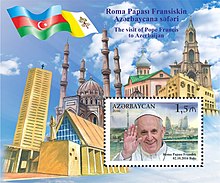
Pope Francis continued in the tradition of the Second Vatican Council and of the papacies since the Council in promoting ecumenism with other Christian denominations, as well as encouraging dialogue with leaders of other religions; he has also supported peace with those claiming no religious belief.
Clerical titles
In January 2014, Francis said that he would appoint fewer monsignors and only assign those honoured to the lowest of the three surviving ranks of monsignor, chaplain of His Holiness. It would be awarded only to diocesan priests at least 65 years old. During his 15 years as archbishop of Buenos Aires, Francis never sought the title for any of his priests. It is believed he associates it with clerical careerism and hierarchy, though he did not apply this restriction to clergy working in the Roman Curia or diplomatic corps, where careerism is an even greater concern.[243]
Canonizations and beatifications

Francis presided over the first canonizations of his pontificate on 12 May 2013 in which he canonized the Martyrs of Otranto. Antonio Primaldo and his 812 companions who had been executed by the Ottomans in 1480,[244] as well as the religious sisters Laura of St. Catherine of Siena and María Guadalupe García Zavala – in this first canonization he surpassed the record of Pope John Paul II in canonizing the most saints in a pontificate.[204] Francis approved the equipollent canonization of Angela of Foligno the following 9 October and then the Jesuit Peter Faber the following 17 December.[245][246]
The pope approved further equipollent canonizations on 3 April 2014 for the Jesuit José de Anchieta as well as the Ursuline nun Marie of the Incarnation and bishop François de Laval.[247] Francis canonized his two predecessors John XXIII and John Paul II on 27 April 2014 and canonized six additional saints the following 23 November.[248][249] The pope canonized Joseph Vaz on his visit to Sri Lanka on 14 January 2015 and canonized a further four saints on the following 17 May; he canonized Junípero Serra on 23 September while visiting the United States and then canonized four saints on 18 October including the first married couple to be named as saints.[250][251][252][253] Francis canonized Maria Elisabeth Hesselblad and Stanislaus Papczyński on 5 June 2016 and then canonized Teresa of Calcutta on 4 September; he canonized seven additional saints on 16 October.[254][255][256] The pope canonized the two child visionaries Francisco and Jacinta Marto during his visit to Fátima in mid-2017 and canonized 35 additional saints on 15 October.[257][258] Francis recognized seven saints, including his predecessor Pope Paul VI and Óscar Romero, on 14 October 2018.[259] Francis later confirmed the equipollent canonization for Bartholomew of Braga in mid-2019.[260] On 13 October 2019, Francis canonized five new saints, including Cardinal John Henry Newman.[261] The pope confirmed the equipollent canonization for Margherita della Metola on 24 April 2021.[262]
The pope has also continued the practice of having beatifications celebrated in the place of the individual's origin though has presided over beatifications himself on three occasions: for Paul Yun Ji-Chung and 123 companions on 16 August 2014, his predecessor Pope Paul VI on 19 October 2014, and two Colombian martyrs on 8 September 2017.[263][264][265] The pope has approved beatifications for a range of men and women including the likes of Álvaro del Portillo of Opus Dei (27 September 2014), the martyred archbishop Óscar Romero (23 May 2015), the prominent Polish cardinal Stefan Wyszyński (12 September 2021), and several large groups of Spanish martyrs.[266]
Francis also confirmed his predecessor John Paul I to be Venerable on 8 November 2017,[267] and Blessed on 4 September 2022.[268]
Doctors of the Church
Francis declared two new Doctors of the Church: Saint Gregory of Narek as the 36th Doctor of the Church (conferred in 2015 with delegations from the Armenian Catholic Church and the Armenian Apostolic Church present),[269] and Saint Irenaeus of Lyon as the 37th Doctor of the Church (conferred in 2022).[270] Francis also conferred upon Irenaeus the supplementary title Doctor unitatis ("Doctor of Unity").[270]
Consistories
As of March 2024, Francis had, over the 11 years of his papacy, created 142 cardinals from 70 nations across nine consistories.[271] He held his first consistory in February 2014, a rare occasion in which he publicly appeared with his predecessor, Benedict XVI.[272][273] As of early 2023, the cardinals created by Francis, 113 were under the age of eighty, and thus eligible to vote for the pope at a papal conclave.[271] There were at that point 94 cardinal-electors created by Francis, 27 created by Benedict XVI, and eight created by John Paul II.[271]
Francis' appointments made the College of Cardinals less European-dominated.[274] Of cardinals appointed by Francis, 22 were based in countries that had never before had a cardinal.[271] In 2023, Europe accounted for 39% of voting-age cardinals (down from 52% in 2013) and North America accounted for 10% of voting-age cardinals (down from 12% in 2013).[274] Other regions of the world increased: the Asia–Pacific and Latin America and the Caribbean accounted for 18% of voting-age cardinals (up from 9% and 16%, respectively, in 2013).[274] Francis appointed many cardinals from developing countries, including some of the world's poorest, and from countries on the peripheries of the church.[275] He raised to the cardinalate Chibly Langlois from Haiti and Philippe Nakellentuba Ouedraogo from Burkina Faso (in 2014),[272] Charles Maung Bo of Myanmar and Soane Patita Paini Mafi of Tonga (in 2015),[276] Patrick D'Rozario from Bangladesh and Dieudonné Nzapalainga from the Central African Republic (in 2018).[277] In a 2020 consistory,[278] the pope appointed the first cardinals from Brunei and Rwanda, as well as the first African American cardinal (Wilton Daniel Gregory), the first Conventual Franciscan in almost 160 years (Mauro Gambetti), and the first cardinal from Siena since 1801 (Augusto Paolo Lojudice).[279]
Compared to his predecessors, Francis made fewer appointments of Roman Curia officials to the cardinalate. At the 2013 conclave that elected Francis pope, 35% of cardinals were from the Curia; by late 2023, Curia officials made up just under 23% of cardinal-electors.[275] This was part of a general trend under Francis to a more decentralized church.[280] Compared to his predecessor Benedict, who preferred to appoint academically inclined churchmen as cardinal, Francis favored cardinals with a more pastoral focus,[275] especially those known for a focus on the poor and marginalized, such as refugees and the homeless.[281] Francis dropped the traditional custom of always appointing the archbishops of certain historically prominent sees (such as the Patriarch of Venice and Archbishop of Milan) as cardinals.[275]
Year of Mercy
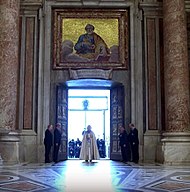
With his April 2015 papal bull of indiction, Misericordiae Vultus (Latin: "The Face of Mercy"), Francis inaugurated a Special Jubilee Year of Mercy, to run from 8 December 2015, Solemnity of the Immaculate Conception of the Blessed Virgin Mary, to the last Sunday before Advent and the Solemnity of the Feast of Christ the King of the Universe on 20 November 2016.
The Holy Doors of the major basilicas of Rome (including the Great Door of St. Peter's) were opened, and special "Doors of Mercy" were opened at cathedrals and other major churches around the world, where the faithful can earn indulgences by fulfilling the usual conditions of prayer for the pope's intentions, confession, and detachment from sin, and communion.[282][283] During Lent of that year, special 24-hour penance services will be celebrated, and during the year, special qualified and experienced priests called "Missionaries of Mercy" will be available in every diocese to forgive even severe, special-case sins normally reserved to the Holy See's Apostolic Penitentiary.[284][285]
Francis established the World Day of the Poor in his Apostolic Letter, Misericordia et Misera, issued on 20 November 2016 to celebrate the end of the Extraordinary Jubilee of Mercy.[286][287]
COVID-19 pandemic
During the COVID-19 pandemic, Francis cancelled his regular general audiences at St. Peter's Square to prevent crowds from gathering and spreading the virus, which seriously affected Italy.[288] He encouraged priests to visit patients and health workers;[289] urged the faithful not to forget the poor during the time of crisis;[290] offered prayers for people with the virus in China;[291] and invoked the Blessed Virgin Mary under her title Salus Populi Romani, as the Diocese of Rome observed a period of prayer and fasting in recognition of the victims.[292] The pontiff reacted with displeasure on 13 March 2020, at the news that the Vicar General had closed all churches in the Diocese of Rome. Despite Italy being under a quarantine lockdown, Francis pleaded "not to leave the ... people alone" and worked to partially reverse the closures.
On 20 March 2020, Francis asked the Dicastery for Promoting Integral Human Development (DPIHD) to create a Vatican COVID-19 Commission to express the church's concern for the crisis generated by the COVID-19 pandemic and propose responses to the potential socio-economic challenges deriving from it.[293][294]
On 27 March, Francis gave an extraordinary benediction Urbi et Orbi.[295] In his homily on calming the storm in the Gospel of Mark, Francis described the setting: "Dense darkness has thickened on our squares, streets and cities; it looks over our lives filling everything with a deafening silence and a desolate void that paralyzes everything in its passage: you can feel it in the air, you can feel it in your gestures. ...In the face of suffering, where the true development of our peoples is measured, we discover and experience the priestly prayer of Jesus: 'may all be one'."[296]
Francis maintains getting COVID vaccination is a moral obligation. Francis stated that people had a responsibility to look after themselves, "and this translates into respect for the health of those around us. Health care is a moral obligation."[297]
In response to the economic harm created by the COVID-19 pandemic, Francis stated that now is the time to consider implementing a universal basic wage.[298]
Death penalty
Francis has committed the Catholic Church to the worldwide abolition of the death penalty in any circumstance.[299] In 2018, Francis revised the Catechism of the Catholic Church to read that "in the light of the Gospel" the death penalty is "inadmissible because it is an attack on the inviolability and dignity of the person" and that the Catholic Church "works with determination for its abolition worldwide".[299][300]
In his 2020 encyclical Fratelli tutti, Francis repeated that the death penalty is "inadmissible" and that "there can be no stepping back from this position".[301]
On 9 January 2022, Pope Francis stated in his annual speech to Vatican ambassadors: "The death penalty cannot be employed for a purported state justice, since it does not constitute a deterrent nor render justice to victims, but only fuels the thirst for vengeance".[10]
Role of women
Francis has categorically rejected the ordination of women as priests.[15] Early in his papacy, he initiated dialogue on the possibility of deaconesses, creating in 2016 a Study Commission on the Women's Diaconate to research the role of female deacons in early Christianity.[302] Its report was not made public,[303] but Francis said in 2019 that the commission issued a split report and was unable to come to a consensus.[304] In April 2020, Francis empaneled a new commission, led by Cardinal Giuseppe Petrocchi and with an entirely new membership, to study the issue.[305] Francis delayed a decision on the issue for several years.[15] In interviews in late 2023 and 2024, he appeared to reject the idea of women deacons, saying that "holy orders is reserved for men."[306][303] Francis said that "the fact that the woman does not access ministerial life is not a deprivation, because her place is much more important"[306] and that women had a charism separate from "the ministerial way."[303]
In January 2021, Francis issued a Spiritus Domini, allowing bishops to institute women to the ministries of acolyte and lector. While these instituted ministries were previously reserved to men, Catholic women already carried out these duties without institution in most of the world. Francis wrote that these ministries are fundamentally distinct from those reserved to ordained clergy.[307][308][309] The following month, Francis appointed women to several positions previously held only by men: a French member of the Xaviere Missionary Sisters, Nathalie Becquart, was appointed co-undersecretary of the Synod of Bishops, and Italian magistrate Catia Summaria became the first woman Promoter of Justice in the Vatican's Court of Appeals.[310]
In April 2023, Francis announced that 35 women would be allowed to vote at the Sixteenth Ordinary General Assembly of the Synod of Bishops (making up "just over 10 percent" of all voters),[311] marking the first time women are allowed to vote at any Catholic Synod of Bishops.[312]
Financial corruption
Francis was mandated by electing cardinals to sort out Vatican finances following scandals during the papacies of Pope Benedict and Pope John Paul II. He stated he is determined to end corruption in the Catholic Church but is not very optimistic due to it being a human problem dating back centuries.[313]
Apologies for Church abuses toward indigenous peoples
Early in 2022, Francis expressed "shame and sorrow" for the Catholic Church's role in abuses against the indigenous peoples in Canada and "the lack of respect" toward indigenous cultures.[314] Late, in July 2022, Francis made an apostolic journey to Canada, where he expressed sorrow, indignation, and shame over the church's abuse of Canadian indigenous children in residential schools.[315] Francis described the Canadian Catholic Church's role as compromising a "cultural genocide".[14] He apologized for the church's role in "projects of cultural destruction" and forced assimilation.[315] Near the former Ermineskin Indian Residential School, the site of several unmarked graves, Francis said: "I humbly beg forgiveness for the evil committed by so many Christians against the Indigenous peoples."[314] He visited the Ermineskin Cree Nation's cemetery at its Maskwacis reservation south of Edmonton.[314] Francis promised a serious investigation into the history of abuse.[315]
Sexual abuse response
In 2010, then-Cardinal Bergoglio commissioned a study which concluded that Father Julio César Grassi, a priest convicted of child sexual abuse, was innocent, that his victims were lying, and that the case against him never should have gone to trial.[316] However, the Supreme Court of Argentina upheld the conviction and 15-year prison sentence against Grassi in March 2017.[316]
Early in his papacy, Francis chosen a more lenient sentence for Mauro Inzoli, an Italian priest accused of child sexual abuse.[317] A church tribunal had ruled that Inzoli should be laicized (defrocked),[318] and he was defrocked in 2012 by Francis's predecessor Benedict.[317] Francis, however, reversed this decision in 2014; Francis agreed with the bishop of Crema that Inzoli should remain a priest but be removed from public ministry and ordered to retire to "a life of prayer and humble discretion."[317][318] Izoli was convicted of sexually abusing children in Italian civil court in 2016, and sentenced to prison.[317] In unscripted remarks to the Pontifical Commission for the Protection of Minors in September 2017, Francis admitted that he mishandled the Inzoli case, saying that as a new pope, "I did not understand these things well and chose the more benevolent of the two sentences but after two years the priest had a relapse. I learned from this."[318] In the same remarks, he that the church "arrived late" in dealing with sexual abuse cases.[318]
In 2015, Francis was criticized for supporting Chilean bishop Juan Barros, who was accused of covering up Catholic Church sexual abuse cases in Chile, including crimes committed against minors.[319] In 2018, Francis acknowledged he had made "grave errors" in judgement about Barros, apologized to the victims and launched a Vatican investigation that resulted in the resignation of three Chilean bishops: Barros, Gonzalo Duarte, and Cristián Caro.[320]
In 2019, Francis defrocked Theodore McCarrick, a former archbishop of Washington, who maintained a prominent position in the church for decades despite repeated reports of sexual misconduct against him dating back to the 1980s. In 2017, after renewed allegations against McCarrick, Francis commissioned a Vatican investigation, which found that McCarrick had sexually molested both adults and minors.[321] In July 2018, McCarrick resigned from the College of Cardinals; in October 2018, Francis ordered a review of the Church's "institutional knowledge and decision-making" related to McCarrick.[322] Francis authorized the release, in November 2020, of the 449-page report of the Vatican's two-year investigation into McCarrick's career, based on a review of documents and interviews with more than 90 people.[322][321] The report largely faulted Pope John Paul II, who appointed McCarrick as archbishop in 2000 and accepted the churchman's denials of sexual abuse, despite multiple reports.[321] The report also found that Pope Benedict XVI placed informal restrictions on McCarrick, but these were never enforced, and Benedict did not investigate or formally sanction McCarrick even after he disregarded those informal restrictions.[321] The report concluded that Francis, before 2017, "had heard only that there had been allegations and rumors related to immoral conduct with adults occurring prior to McCarrick's appointment to Washington" and continued the approach of his predecessors John Paul and Benedict.[321]
Francis convened a four-day summit on sexual abuse in February 2019, organized by Hans Zollner; some abuse survivors expressed disappointment that the summit did not result in concrete rules on abuse prevention, responses to abuse, and Church cooperation with law enforcement authorities.[323] In December 2019, Francis abolished the "pontifical secrecy" privilege in sexual abuse cases, clarifying that bishops do not need authorization from the Vatican to turn over to materials from canonical trials upon request of civil law enforcement authorities.[240][324] The liftng of the confidentiality rule was praised by victim advocates, but did not require the Church to affirmatively turn over canonical documents to civil authorities.[240][324]
In November 2021, Francis thanked journalists for their work uncovering child sexual abuse scandals in the church, thanking journalists also for "helping us not to sweep it under the carpet, and for the voice you have given to the abuse victims".[325]
In November 2022, French Cardinal Jean-Pierre Ricard admitted to having sexually abused a 14-year-old girl in the 1980s in Marseille. Ricard (who was named as cardinal by Benedict XVI in 2006[326]) said that he committed "reprehensible" acts with the girl while he was a priest. French authorities opened an investigation into the case while Francis commented that now that "everything is clearer [...] more cases like this shouldn't surprise [anyone]", and added condemnation for sexual abuse, saying it's "against priestly nature, and also against social nature".[327][328]
Francis visited Ireland in 2018, marking the first papal tour of the country since John Paul II's historic trip in 1979.[329] He apologized for sexual abuses by clergy in the United States and Ireland.[330]
G7
During his speech at the G7 forum in Italy, he stressed that humanity is in great danger, due to the wars that are taking place such as the war in Ukraine, in Gaza, the excessive use of artificial intelligence that is posing a risk to jobs in the world, and reproductive practices without mentioning abortion. Pope Francis made history as the first pontiff to participate in the G7, a meeting of leaders of the largest economies in the world.[331][332][333][334]
Theological emphases and teachings
In Evangelii gaudium Francis revealed what would be the emphases of his pontificate: a missionary impulse among all Catholics, sharing the faith more actively, avoiding worldliness and more visibly living the gospel of God's mercy, and helping the poor and working for social justice.[335]
Since 2016, criticism against Francis by theological conservatives has intensified.[336][337][338][339][340] One commentator has described the conservative resistance against Francis as "unique in its visibility" in recent church history.[341] Some have explained the level of disagreement as due to his going beyond theoretical principles to pastoral discernment.[342]
Evangelization
From his first major letter Evangelii gaudium (Joy to the World), Francis called for "a missionary and pastoral conversion" whereby the laity would fully share in the missionary task of the church.[225][343] Then in his letter on the call of all to the same holiness, Gaudete et exsultate, Francis describes holiness as "an impulse to evangelize and to leave a mark in this world".[344]
Church governance
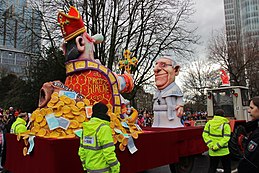
Francis called for decentralization of governance away from Rome, and for a synodal manner of decision making in dialogue with the people.[345] He strongly opposed clericalism[346] and made women full members of the church's dicasteries in Rome.[347]
Environment and climate change
Francis's naming of himself after Francis of Assisi was an early indication of how he shared Francis's care for all of creation. This was followed in May 2015 with his major encyclical on the environment, Laudato si' (Praise be to you).[348] In October 2023, in advance to the 2023 United Nations Climate Change Conference (COP28), Francis issued the apostolic exhortation Laudate Deum (Praise god), in which he called for decisive action to against the climate crisis and condemned climate change denial.[349][350] Francis also argued that the United Arab Emirates, which hosted COP28, had a "conflict of interest" because "although it has made significant investments in renewable energy sources" it was still "a great exporter of fossil fuels."[351] Francis planned to attend the conference, which would have been the first time for a pope to personally visit the a UN climate change conference,[352] but cancelled the trip after developing flu-like symptoms.[353]
In a May 2017 meeting with U.S. President Donald Trump, the Vatican's secretary of state, Pietro Parolin, raised the issue of climate change and encouraged Trump not to withdraw the U.S. from the Paris Agreement.[354] At the 2017 World Food Day ceremony the following month, Francis reiterated that "we see the consequences [of climate change] every day" and that we "know how the problems are to be faced ... [t]hanks to scientific knowledge." He said that "the international community has drawn up the necessary legal instruments, such as the Paris Agreement, from which however some are withdrawing. There is a re-emergence of the nonchalance towards the delicate balances of ecosystems, the presumption of being able to manipulate and control the planet's limited resources, and greed for profit."[355]
In 2024, Francis organized a climate summit that issued a Planetary Protocol for Climate Change Resilience including three main pillars: reducing greenhouse gas emissions (while prioritizing nature-based solutions), climate change adaptation and societal transformation.[356]
Option for the poor
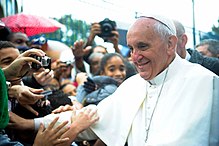
Francis has highly extolled "popular movements", which demonstrate the "strength of us", serve as a remedy to the "culture of the self", and are based on solidarity with the poor and the common good.[357] He has praised liberation theology founder Gustavo Gutierrez.[358] In 2024, while meeting with representatives of the Dialop group, a discussion group between Christians and Marxists, Pope Francis encouraged them to fight together, and stated that marxists and Christians have a common mission.[359]
Morality
Cardinal Walter Kasper has called mercy "the key word of his pontificate".[360]: 31–32 His papal motto Miserando atque eligendo ("by having mercy and by choosing") contains a central theme of his papacy, God's mercy,[361][362] While maintaining the Catholic Church's traditional teaching against abortion, Francis, has referred to the "obsession" of some Catholics with a few issues like "abortion, gay marriage and the use of contraceptive methods" which "do not show the heart of the message of Jesus Christ".[363]
Sex
Pope Francis has described sexual pleasure as "a gift from God" that should be "disciplined with patience".[364] On 17 January 2024 he discussed sex at his weekly general audience saying that it was undermined by pornography, which provides "satisfaction without relationship that can generate forms of addiction".[365] He added that "in Christianity, there is no condemnation of the sexual instinct" and that the human experience of falling in love is "one of the purest feelings."[365]
LGBT
Francis has marked a significantly more accommodative tone on LGBT topics than his predecessors.[366] In July 2013, his televised "Who am I to judge?" statement was widely reported in the international press, becoming one of his most famous statements on LGBT people.[367][368][369] In other public statements, Francis has emphasised the need to accept, welcome, and accompany LGBT people,[370][371][372] including LGBT children.[373][374] In a January 2023 interview with the Associated Press, Francis denounced the criminalization of homosexuality (which he called "unjust"); he called on the Catholic Church to "distinguish between a sin and crime" and asked bishops supporting such laws to reverse their position.[375][368][376] Francis repeated this stance the following month.[368] Francis reiterated traditional Catholic teaching that marriage is between a man and a woman,[377][378] he has supported same-sex civil unions as legal protections for same-sex couples.[374][379] Under his pontificate, the Dicastery for the Doctrine of the Faith has confirmed that transgender people can be baptised,[380][381] and allowed the blessing of same-sex couples in the document Fiducia supplicans.[382] Francis has privately met many LGBT people and activists. In 2013, Francis was named as Person of the Year by The Advocate, an American LGBT magazine.[383]
Relative to LGB topics, Francis has been less accommodative on transgender topics.[366] He described gender theory and children's education on gender-affirming surgery as "ideological colonisation".[384][367] In September 2015, Francis met with Kim Davis, a county clerk who was jailed for six days for contempt of court for refusing to marriage licences for same-sex couples,[385][386] and in August 2018, Francis was criticized for suggesting that gay children seek psychiatric treatment.[387] As Archbishop of Buenos Aires, Bergoglio led public opposition to the parliamentary bill on legalizing same-sex marriage in Argentina, which was approved by the Argentine Senate in 2010.[388] A letter he wrote in that campaign was criticized for using "mediaeval" and "obscurantist" language.[389][390][391] A church source quoted in the Argentine newspaper La Nación called the letter a strategic error that contributed to the bill's success.[392]
International policy
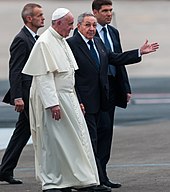
Francis has regularly been accused by conservatives of having a "soft spot" for leftist populist movements.[393] After Francis's visit to Cuba in 2015, Catholic Yale historian Carlos Eire said Francis had a "preferential option for the oppressors" in Cuba.[394] Francis is hostile to right-wing populism.[395] Since 2016, Francis has been contrasted with US President Donald Trump,[396] elected that year, with some conservative critics drawing comparisons between the two.[397][398] During the 2016 United States presidential election, Francis said of Trump, "A person who only thinks about building walls, wherever they may be, and not building bridges, is not Christian. That is not the gospel." Trump responded, "For a religious leader to question a person's faith is disgraceful."[13] Federico Lombardi said that Francis's comments were not "a personal attack, nor an indication of who to vote for".[399]
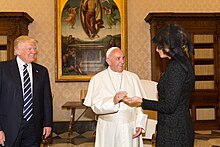
In response to criticism from Venezuela's bishops, President Nicolás Maduro said in 2017 that he had the support of Francis.[400][401] Francis met with the country's bishops in June 2017, and the Venezuelan bishops' conference president stated, "There is no distance between the episcopal conference and the Holy See."[402] In January 2019, 20 former presidents in Latin America wrote a letter to Francis criticizing his Christmas address regarding the ongoing Venezuelan crisis for being too simplistic and for not acknowledging what they believed to be the causes of the suffering of the victims of the crisis.[403] Francis has sought peace in the crisis without picking a side.[404]
Position toward China
Francis took a more conciliatory approach toward the People's Republic of China than any previous pope.[405] He continued the Vatican's longstanding diplomatic recognition of the Republic of China (Taiwan), rather than the People's Republic of China; the Vatican City State is the only county in Europe to formally recognize Taiwan, and one of just 12 countries worldwide to do so.[406][407] In 2018, however, Francis approved a provisional Vatican-China agreement, intended to normalize the situation of China's Catholics, who numbered approximately 10 million as of 2024.[405] The Chinese government claims the authority to appoint bishops, without papal approval, through the state-controlled Chinese Catholic Patriotic Association, in contravention of longstanding church doctrine.[405] Under the 2018 agreement, the Vatican consults with the Chinese government on the appointment of bishops, and pledged not to appoint any bishop in China without Beijing's approval;[405] in return, the Chinese government recognized the pope as the supreme head of the Catholic Church.[408] The agreement was renewed for an additional two years in 2020,[409] and again in 2022.[408][409]
Francis' efforts toward rapprochement with China, were highly controversial; a leading critic, Cardinal Joseph Zen, said the 2018 agreement was a step toward the "annihilation" of the Catholic Church in China.[405][410][411] Critics said that the 2018 agreement "sold out" Chinese Catholics by accepting infringements on religious freedom, thereby undermining the Vatican's spiritual authority.[408][405] In September 2020, U.S. Secretary of State Mike Pompeo, a critic of the agreement, urged Francis to stand against China's human rights violations.[412][413]
The Chinese government repeatedly violated the 2018 deal with the Vatican.[408][414] Francis has defended the Vatican's dialogue with China on the appointment of new bishops, saying in 2021 that uneasy dialogue was better than no dialogue at all, and that improving strained ties with the Chinese government was important.[415] From the signing of the agreement until 2022, only six Catholic bishops in China were appointed.[408] In November 2022, the Vatican publicly accused China of violating the agreement by installing John Peng Weizhao as an auxiliary bishop in Jiangxi without Vatican approval.[408] In April 2023, the Chinese government also installed Joseph Shen Bin as bishop of Shangahi without Vatican approval in violation of the agreement; three months later, Francis recognized Shen Bin's appointment; the Vatican secretary of state, Pietro Parolin, said that the pope had done so "remedy the canonical irregularity created in Shanghai, in view of the greater good of the diocese and the fruitful exercise of the bishop's pastoral ministry."[409]
In November 2020, Francis named China's Uyghur minority among a list of the world's persecuted peoples. He wrote: "I think often of persecuted peoples: the Rohingya [Muslims in Myanmar], the poor Uighurs, the Yazidi—what ISIS did to them was truly cruel—or Christians in Egypt and Pakistan killed by bombs that went off while they prayed in church." Zhao Lijian, the spokesman of the Foreign Ministry of China, said Francis's remarks had "no factual basis at all".[416]
In 2019, during the Hong Kong pro-democracy protests, Francis was criticized by Zen and other Catholic clergy in Hong Kong for failing to taking a stand against China's repression and instead being quoted as saying "I would like to go to China. I love China." Francis compared the protests in Hong Kong to those seen in Chile and in France.[417]
Theological disagreements
Amoris laetitia and the communion to the divorced and civilly remarried
On a theological level, controversy arose after the publication of the apostolic exhortation Amoris laetitia, especially regarding whether the exhortation had changed the Catholic Church's sacramental discipline concerning access to the sacraments of Penance and the Eucharist for divorced couples who have civilly remarried.[418] Francis had written: "It is important that the divorced who have entered a new union should be made to feel part of the Church." He called not for "a new set of general rules, canonical in nature and applicable to all cases", but "a responsible personal and pastoral discernment of particular cases". He went on to say: "It is true that general rules set forth a good which can never be disregarded or neglected, but in their formulation they cannot provide absolutely for all particular situations."[419]
Four cardinals (Raymond Leo Burke, Carlo Caffarra, Walter Brandmüller, and Joachim Meisner) formally asked Francis for clarifications, particularly on the issue of giving communion to divorced and civilly remarried Catholics.[420] They submitted five "dubia" (doubts), and requested a yes or no answer. Francis has not publicly replied.[421] The exhortation has been implemented in different ways by various bishops around the world.[422]
Cardinal Gerhard Müller, former prefect of the Congregation for the Doctrine of the Faith, maintained that Amoris Laetitia should only be interpreted in line with previous doctrine. Therefore, according to Cardinal Müller, divorced and civilly remarried can have access to the Sacraments of Reconciliation and the Eucharist only if they take on the duty of living in complete continence.[423][424] Francis subsequently announced that dicastery prefects would be appointed for a single five-year term, and replaced Müller at the end of his term in 2017 with Luis Ladaria Ferrer.[425] Cardinal Carlo Caffarra, one of the authors of the dubia, maintains that after Amoris laetitia "only a blind man could deny there's great confusion, uncertainty and insecurity in the Church".[426]
In July 2017 a group of conservative clergy, academics and laymen signed a document labelled as a "Filial Correction" of Francis.[427] The 25-page document, which was made public in September after it received no reply, criticized the pope for promoting what it described as seven heretical propositions through various words, actions and omissions during his pontificate.[428] Capuchin Father Thomas Weinandy, ex-doctrine chief of US Bishops, wrote a letter to Francis on 31 July 2017, which he subsequently made public, in which he charged that Francis is fostering "chronic confusion", "demeaning" the importance of doctrine, appointing bishops who "scandalize" believers with dubious "teaching and pastoral practice", giving prelates who object the impression they will be "marginalized or worse" if they speak out, and causing faithful Catholics to "lose confidence in their supreme shepherd".[429]
A defence of Amoris Laetitia came from philosopher Rocco Buttiglione who accused its critics of "ethical objectivism". He said that the critics cannot deny that "there are mitigating circumstances in which a mortal sin (a sin that would otherwise be mortal) becomes a lighter sin, a venial sin. There are therefore some cases in which remarried divorcees can (through their confessor and after an adequate spiritual discernment) be considered in God's grace and therefore deserving of receiving the sacraments".[430]
Document on Human Fraternity
The Document on Human Fraternity for World Peace and Living Together is a joint statement signed by Francis and Sheikh Ahmed el-Tayeb, Grand Imam of Al-Azhar, on 4 February 2019 in Abu Dhabi, United Arab Emirates. This joint statement is concerned with how different faiths can live peaceably in the same world and areas and later inspired the International Day of Human Fraternity, as acknowledged by the UN Secretary-General, António Guterres, in different occasions.[431][432] Criticisms focused particularly on the passage about God's will with regard to the diversity of religions, claiming that the "pluralism and the diversity of religions, colour, sex, race and language are willed by God in His wisdom, through which He created human beings".[433][434] Catholic theologian Chad Pecknold wrote that this sentence was "puzzling, and potentially problematic".[435] Some Catholic observers tried to understand it as an allusion to the "permissive will" of God, allowing evil on earth.[434] Pecknold wrote that the diversity of religions might also be "evidence of our natural desire to know God".[435] Bishop Athanasius Schneider claims that Pope Francis clarified to him that he was referring to "the permissive will of God".[436]
Traditionis custodes and the restriction of the Tridentine Mass
In July 2021, Francis issued, motu proprio, the apostolic letter titled Traditionis custodes, which reversed the decision of his immediate predecessor Benedict XVI in Summorum Pontificum and imposed new restrictions on the use of the Traditional Latin Mass. The letter returned to the bishops the power to grant or suppress the Latin Mass in their particular dioceses, and requires newly ordained priests to first request permission before performing the old rite, among other changes.[437][438] Traditionis custodes, which Pope Francis published and came into immediate effect on 16 July, has been criticized by prelates such as Cardinals Raymond Burke, Gerhard Müller and Joseph Zen, as well as many lay faithful who attend the traditional Latin Mass. The National Catholic Register' reported that "The most general criticism is that the restrictions are unnecessary, needlessly harsh, and implemented in an unjustifiably swift fashion."[439] The motu proprio was later confirmed by Francis through the apostolic letter Desiderio desideravi.[440]
Fiducia supplicans and the blessing of couples in irregular situations
In December 2023, the Dicastery for the Doctrine of the Faith issued a declaration, Fiducia supplicans, approved by Francis.[441] Fiducia supplicans intended to provide clarification and reforms on the Catholic Church's treatment of "irregular relationships", defined as those who establish a monogamous and emotional bond that lasts over time and have not contracted a Catholic marriage. Notably, it allows Catholic priests to perform "spontaneous blessings" of same-sex couples, as well as opposite-sex couples who are not married, and civilly married couples at least one party of which was previously divorced but has not received an annulment.[442]
Fiducia supplicans sparked considerable controversy and criticism among Catholics, including from several conservative commentators, clerical congregations, and high-profile cardinals, bishops, priests, and lay people.[443][444][445] Cardinal Gerhard Müller called it "sacrilegious and blasphemous" and "self-contradictory".[446] Cardinal Robert Sarah described the blessing of couples in irregular situations as "a heresy that seriously undermines the Church".[447] On 11 January 2024, Cardinal Fridolin Ambongo Besungu announced that all episcopal conferences in Africa, represented in SECAM, would reject blessings for same-sex couples, stating that "the extra-liturgical blessings proposed in the declaration...cannot be carried out in Africa without exposing themselves to scandals".[448][449]
International diplomatic role
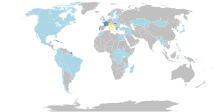
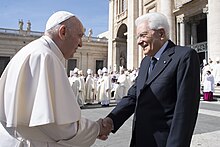
Cuba
Francis played a key role in the talks toward restoring full diplomatic relations between the U.S. and Cuba. The restoration was jointly announced by U.S. President Barack Obama and Cuban President Raúl Castro on 17 December 2014. The headline in the Los Angeles Times on 19 December was "Bridge to Cuba via Vatican", with the further lead "In a rare and crucial role, Francis helped keep U.S. talks with Havana on track and guided final deal."[450] The pope, along with the Government of Canada, was a behind-the-scenes broker of the agreement, taking the role following President Obama's request during his visit to the pope in March 2014.[451] The success of the negotiations was credited to Francis because "as a religious leader with the confidence of both sides, he was able to convince the Obama and Castro administrations that the other side would live up to the deal".[450] En route to the United States for a visit in September 2015, the pope stopped in Cuba. "The plan comes amid a breakthrough for which Francis has received much credit."[452] The Cuba visit "seals that accomplishment, in which he served as a bridge between two erstwhile enemies".[452] According to one expert on religion in Latin America, Mario Paredes, the pope's visit to Cuba was consistent with his aim to promote an understanding of the role of the Cuban Revolution and that of the Catholic Church. When Francis was archbishop of Buenos Aires, he authored a text entitled "Dialogues Between John Paul II and Fidel Castro".[452] John Paul was the first pope to visit Cuba. In May 2015, Francis met with Cuban leader Raúl Castro. After the meeting in Vatican City on 10 May 2015, Castro said that he was considering returning to the Catholic Church.[453] He said in a televised news conference, "I read all the speeches of the pope, his commentaries, and if the pope continues this way, I will go back to praying and go back to the [Catholic] church. I am not joking."[454] Castro said that, when the pope came, "I promise to go to all his Masses and with satisfaction".[454]

Arab-Israeli conflict
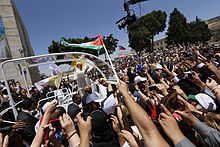
In May 2014, Francis visited Israel and the Palestinian territories.[455][456] Francis offered symbolic gestures to both sides in the Israeli-Palestinian conflict.[456] In addition to visiting the Western Wall, Yad Vashem, and the Church of the Holy Sepulchre, he became the first pope to visit the grave of Theodor Herzl, entered the West Bank from Jordan rather than Israel, and invited Palestinian Authority President Mahmoud Abbas and Israeli President Shimon Peres to a prayer summit at the Vatican (both accepted).[456] He visited Bethlehem, where he gave a speech alongside Abbas, and celebrated Mass at the Church of the Nativity.[456] At the invitation of Israeli Prime Minister Benjamin Netanyahu, he visited the Victims of Acts of Terror Memorial; at the invitation of Palestinian authorities, he prayed at a portion of the Israeli West Bank barrier.[456] In addition to meetings with Peres and Netanyahu, Francis met Grand Mufti of Jerusalem Muhammad Ahmad Hussein, Chief Rabbis Yitzhak Yosef and David Lau, and Rabbi of the Western Wall and the Holy Places Shmuel Rabinowitz.[456]
In May 2015, Francis welcomed Abbas to the Vatican and said that: "The angel of peace destroys the evil spirit of war. I thought about you: may you be an angel of peace."[457] The Vatican signed a treaty recognizing the state of Palestine.[458] The Vatican issued statements concerning the hope that the peace talks could resume between Israel and Palestine. Abbas's visit was on the occasion of the canonization of two Palestinian nuns.[459]
In May 2021, amid clashes in Jerusalem, Francis reiterated calls for peace between Israel and Palestinians during his Regina caeli address.[460][461]
Francis condemned Hamas's October 2023 attack on Israel. He also criticized Israel's actions in the Gaza Strip during the Israel–Hamas war, saying that "terror should not justify terror".[462] He condemned the killing of two Palestinian Christian women by an IDF sniper in Gaza, calling it "terrorism".[463] Throughout the war, Francis has called for an immediate ceasefire, the release of all hostages,[464] and the establishment of a two-state solution.[465]
Migrant and refugee issues
Francis made the plight of refugees and migrants "a core component of his pastoral work" and has defended their rights in dialogue both with Europe and with the United States. In 2019, he placed a statue in St. Peter's Square to bring attention to the Christian imperative involved in their situation (Hebrews 13:2).[466][467][468] In line with this policy, Francis has criticized neo-nationalists and populists who reject the acceptance of refugees.[469][470]
In April 2016, Francis, along with Ecumenical Patriarch Bartholomew and Archbishop Ieronimos II of Athens, visited the Moria refugee camp on the Greek island of Lesbos, to call the attention of the world to the 2015 European migrant crisis. There the three Christian leaders signed a joint declaration.[471]
Sovereign Military Order of Malta
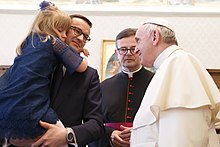
In January 2017, Francis demanded the resignation of Matthew Festing, the 79th Prince and Grand Master of the Sovereign Military Order of Malta. The Pope's demand came as a response to Festing and Cardinal Raymond Leo Burke firing Baron Albrecht von Boeselager from his position in the Order of Malta. The Order, in May 2017, appointed a new leader in the person of Fra' Giacomo Dalla Torre del Tempio di Sanguinetto.[472]
Afghanistan
Following the Taliban takeover of Afghanistan and the withdrawal of U.S. forces from the country, Francis said that the withdrawal of troops was "legitimate" but criticized the withdrawal as "not thought through" and criticized the war for having failed at nation-building. He said the Vatican was in talks with the Taliban through Cardinal Pietro Parolin to discourage the Taliban on taking reprisal measures against civilians.[473][474]
Russia and Ukraine
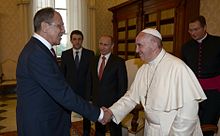
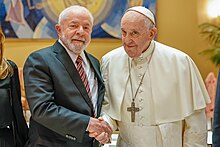
Following the February 2022 Russian invasion of Ukraine, a major escalation of the Russo-Ukrainian War, Francis visited the Russian embassy in Rome, an unprecedented action.[475] He called Ukrainian president Volodymyr Zelenskyy to express "sorrow" as the Vatican worked to find "room for negotiation" to end the war.[476] The day after the invasion began in February 2023, Francis assured Sviatoslav Shevchuk, the major archbishop of the Ukrainian Greek Catholic Church, that "he would do everything he can to help end the Ukraine conflict".[477] During the 27 February 2023 Angelus address, Francis called for peace, saying, "Silence the weapons!"[478]
Throughout the war, Francis has pleaded for an end to armed conflict.[479] In the war's early phase, Francis did not specifically criticize Russia and president Vladimir Putin for their aggression toward Ukraine, frustrating many Ukrainians.[480] Later, Francis referred to Ukraine as "martyred" and offering prayers for the innocent victims of Russian aggression,[480] but still avoided direct criticism of Putin or the Russian government.[481] Instead of aligning with the position of the U.S. and Europe, which have strongly backed Ukraine, Francis' statements were more aligned with countries such as Brazil, India, and China,[481] a stance that some commentators attributed to Francis's distrust of America.[482]
Francis's blanket denunciations of arms transfers and the weapons industry[480][483] seemed to condemn Western military aid provided to Ukraine to defend itself.[481] In a September 2022 press conference, seven months into the war, Francis said that it was "licit" and justified for Ukraine to defend itself but called for a negotiated settlement (saying that there must be "dialogue with any power that is at war, even if it is with the aggressor" and even when "it stinks").[484][485][486] He also suggested that arms transfers to Ukraine were "a political decision which it can be moral, morally acceptable, if it is done under conditions of morality."[484] He later said that Ukrainians were a "noble" people and recounted Cardinal Konrad Krajewski's reports of the "savage acts, the monstrosity, the tortured bodies" inflicted upon Ukraine.[486]
Francis' stances were rooted in part in his hope that the Vatican could broker a peace deal between Ukraine and Russia, a possibility that analysts viewed as extremely unlikely.[480] He dispatched two high-ranking Vatican officials—Cardinals Krajewski and Michael Czerny—as envoys on several trips to Ukraine in 2022.[487][488][489] which was considered a highly unusual move of Vatican diplomacy.[490] In March 2022, Francis consecrated both Russia and Ukraine to the Immaculate Heart of Mary).[491] Francis said in April 2023, during a trip to Budapest, that he was working on a secret "mission" to bring peace and return Ukrainian children abducted by Russia.[492][493] Francis's efforts to position the Vatican as a mediator continuously failed.[481][494]
In April 2022, a delegation of Ukrainian officials, including Melitopol mayor Ivan Fedorov and MP Maria Mezentseva, attended the Vatican Easter vigil with Francis, who said he was prater for an end to the "darkness of war" and "all the suffering." Addressing the group, he also spoke the words "Christ is risen" in Ukrainian.[495]
In May 2022, Francis described Russia's invasion of Ukraine as "perhaps somehow either provoked or not prevent" and suggested that "NATO barking at Russia's gate" contributed to the war.[494][496] These statements alarmed Ukrainians and echoed false Russian narratives about the war, which portray the conflict as being instigated by the West.[494] Francis said he was not "pro-Putin" but instead was "simply against reducing complexity to the distinction between good guys and bad guys."[496]
In August 2022, Francis described the killing of Darya Dugina as a case of the death of innocents in the war. Ukraine's ambassador envoy to the Holy See raised a protest, saying that Dugina was "one of ideologists of (Russian) imperialism" and not an innocent victim.[497]
In early October 2022, Francis for the first time directly appealed to Putin to halt the stop the "spiral of violence and death" in Ukraine.[498] He said that a nuclear escalation would bring "uncontrollable global consequences."[499] In the same speech, Francis asked Ukrainian president Zelenskyy to be open about "serious peace proposals" while recognizing that Ukraine had suffered an "aggression" and saying that he was "pained about the suffering of the Ukrainian people".[499] Later that month, Francis denounced Russia's bombing of Ukrainian cities and the "hurricane of violence" against Ukrainian civilians.[498]
In a November 2022 interview with America magazine, Francis was asked about his "seeming unwillingness to directly criticize Russia" and his preference "instead to speak more generally of the need for an end to war, an end to mercenary activity rather than Russian attacks, and to the traffic in arms"; the pope responded that "Generally, the cruelest are perhaps those who are of Russia but are not of the Russian tradition, such as the Chechens and Buryats and so on..."[500] Russian foreign ministry spokesperson Maria Zakharova condemned the comments as "perversion on a level I can't even name" and others remarked that his statement was "racist" and that there was no data supporting this claim concerning Russian soldiers who are non-ethnic Russians.[501] Francis also stated during the interview: "Certainly, the one who invades is the Russian state. This is very clear."[500]
In August 2023, Francis infuriated Ukraine by making off-the-cuff remarks to a group of young Russian Catholics praising the Russian Empire as "great" and urging them not to "forget your heritage" as descendants "the great Russia of saints, rulers, the great Russia of Peter I, Catherine II."[479] The pope's remarks echoed Vladimir Putin's rhetoric valorizing Russian imperialism, and was praised by the Kremlin; Archbishop Sviatoslav Shevchuk, the leader of the Ukrainian Greek Catholic Church (an Eastern rite church in communion with Rome) said the pope's statement had caused "great pain and worry" because it reflected the "neo-colonial ambitions of the aggressor country."[479][502] Peter the Great and Catherine the Great suppressed Ukrainian and Polish national movements.[502] Following the criticism, the pope's spokesman said the pontiff's intent was to promote positive aspects of Russia's "cultural and spiritual heritage, and certainly not to extol imperialistic logics and governmental personalities."[479]
In a February 2024 interview with Swiss television station RSI, broadcast the following month, Francis suggested that Ukraine should have the "courage of the white flag, and to negotiate"; the statement was interpreted as a call for Ukraine to negotiate terms of surrender.[480][502] Ukraine was angered by Francis's suggestion that it should yield to Russian aggression, and the statement was criticized by Ukraine President Volodymyr Zelenskyy and German Foreign Minister Annalena Baerbock.[480][502] After the broadcast, a Vatican spokesperson said that Francis meant "cease-fire and negotiation" rather than capitulation.[480][502] The Ukrainian Greek Catholic Church criticized Pope Francis's remarks, saying: "Ukrainians cannot surrender because surrender means death. The intentions of Putin and Russia are clear and explicit. In Putin’s mind, there is no such thing as Ukraine, Ukrainian history, language, and independent Ukrainian church life."[502]
In the Muslim world
Francis condemned the persecution of Christians by ISIL, and supported the use of force to stop Islamic militants from attacking religious minorities in Iraq.[503] In January 2018, Francis met Yazidi refugees in Europe, expressed his support for their right to religious freedom, and called upon the international community "not to remain a silent and unresponsive spectator" to the Yazidi genocide.[504]
In February 2019, Francis visited Abu Dhabi, United Arab Emirates, on the invitation of Mohammed bin Zayed Al Nahyan. Francis became the first pope to celebrate Mass on the Arabian Peninsula, attended by more than 120,000 attendees at the Zayed Sports City Stadium.[505]
In March 2021, Francis held a historic meeting with Iraq's top Shi'ite cleric, Grand Ayatollah Ali al-Sistani, and visited Ur, a site traditionally identified as the birthplace of the prophet Abraham. He and the Iraqi cleric urged the Muslim and Christian communities to work together for peaceful coexistence.[506][507]
Elsewhere
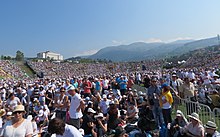
On 6 June 2015, Francis visited Sarajevo, the capital city of Bosnia and Herzegovina, urging peace in the religiously diverse city.[508]
In September 2015, Francis visited the United Nations Headquarters in New York City, where he addressed the UN General Assembly; following his speech, he visited the National September 11 Memorial and Museum.[509] In June 2023, Francis issued an address to the UN Security Council while recovering from abdominal surgery; the statement was read by Vatican official Paul Gallagher on the pope's behalf.[510][511]
On All Souls' Day, on 1 November 2021, Francis visited a war cemetery in Rome and paid tribute to fallen soldiers during the Battle of Anzio in World War II as well as at the Piave River, in Italy, during World War I. Francis also praised military casualties for "fighting for their homeland and values" and called for global peace.[512][513]
Public image
| External videos | |
|---|---|
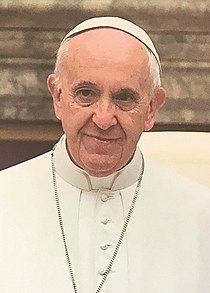 | |
Francis has frequently been depicted as a progressive or liberal moderate.[514] Commentator William Saletan described Francis' comments by Francis in his first long interview in 2013 (particularly Francis's statement that "God is to be encountered in the world of today" and "God manifests himself in historical revelation, in history") as liberal and fundamentally anti-conservative.[515] Other have contested descriptions of Francis as liberal.[516] In 2014, the Vatican criticized some Italian news agencies, as well as the Agence France-Presse, for reporting on certain remarks Francis has made as suggestive of an opening toward acceptance of same-sex marriage or civil unions; a Vatican spokesperson said the pope's remark had been taken out of context.[517]
Important aspects of Francis's public image include "his recognizable humanity" and gestures of humility, as well as his efforts to preserve his autonomy amid Roman Curia bureaucracy.[518] He is a frequent user of landline telephones; he reportedly has never owned a computer or mobile phone.[518]
During Francis's 2015 trip to Cuba, American-based AP and British-based Reuters highlighted the religious aspect of the pope's journey while Prensa Latina, the Cuban state media agency, depicted it as a diplomatic visit. American and British media were also more likely during this trip to show Francis interacting with regular Cubans compared to the official Cuban media, which showed Francis interacting with elites most often.[519]
In December 2013, both Time and The Advocate magazines named the Pontiff as their "Person of the Year"; Esquire magazine named him as the "Best-dressed man" for 2013, citing his simpler vestments.[520] Rolling Stone magazine followed in January 2014 by making the Pontiff their featured front cover.[521][522] Fortune magazine also ranked Francis as number one in their list of 50 greatest leaders.[523] He was included in Forbes lists of most powerful people in the world in 2014[524] and 2016.[525]
In March 2013, a new song was dedicated to Francis and released in Brazilian Portuguese, European Portuguese, and Italian, titled Come Puoi ("How You Can").[146] A street in La Plata, Argentina, was renamed Papa Francisco in his honor.[526] The Argentine Chamber of Deputies passed legislation to mint a commemorative coin as a tribute to Francis in 2013.[527][528] As of 2013, sales of papal souvenirs, a sign of popularity, were up.[529]
Francis presided over his first joint public wedding ceremony in a Nuptial Mass for 20 couples from the Archdiocese of Rome on 14 September 2014, a few weeks before the start of the 5–19 October Third Extraordinary General Assembly of the Synod of Bishops (the Synod on the Family).[530][e]
In 2016, Francis became the first pope to create an Instagram account.[532] He broke records after having gained over one million followers in under twelve hours of the account being up.[533] In 2019 Francis held a conference on the World Day of Social Communications highlighting the pros and cons of social media and urging users to use it as a source that liberates rather than enslaves.[534] On 26 November 2020 Francis became the first pope to write an op-ed for The New York Times; in the article, he addressing issues such as COVID-19 restrictions on public gatherings and the need for global solidarity.[535][536]
Health
In 2021, the pope's health problems prompted rumors that he might resign,[537] which Francis dismissed.[538] In June 2022, after undergoing treatment to the knee, Francis canceled planned trips to the Democratic Republic of the Congo and South Sudan on the advice of his doctors.[539] In an interview with Reuters that month, Francis said that he had not considered resigning but would do so if his health made it impossible for him to run the church.[540] During his trip to the Democratic Republic of the Congo in February 2023, Francis said papal resignations should not become a "fashion" and that resignation was "not in his agenda at the moment".[541] Nearly one million people came for Pope Francis's mass in Kinshasa in the DRC. He addressed people to be in peace and leave weapons. He told people to "put down your arms and embrace mercy".[542]
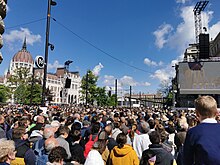
In March 2023, Francis was hospitalized in Rome with a respiratory infection.[543] He returned to celebrate public mass at the Easter Vigil Mass on Holy Saturday, for the first time since recovering from bronchitis.[544]
In June 2023, Pope Francis underwent abdominal surgery after suffering from a hernia. The Pope received the surgery at Gemelli Hospital, and spent several days in the hospital while recovering.[545]
Distinctions
Titles and styles
The official form of address of the pope in English is His Holiness Pope Francis; in Latin, Franciscus, Episcopus Romae. Holy Father is among the other honorifics used for popes.[546]
Foreign orders
 Bolivia:
Bolivia:  : Grand Collar of the Order of the Condor of the Andes (9 July 2015)[547][548]
: Grand Collar of the Order of the Condor of the Andes (9 July 2015)[547][548] Bolivia: Order of Merit "Father Luis Espinal Camps" (9 July 2015)[547][548]
Bolivia: Order of Merit "Father Luis Espinal Camps" (9 July 2015)[547][548] Poland:
Poland:  : Order of the Smile (26 April 2016)[549]
: Order of the Smile (26 April 2016)[549]
Awards
 Germany: International Charlemagne Prize of Aachen 2016.[550]
Germany: International Charlemagne Prize of Aachen 2016.[550]- "Person of the Year" by People for the Ethical Treatment of Animals (2015) for his request that all Catholics be kind to animals.[551]
- Was made an honorary Harlem Globetrotter on 7 May 2015.[552]
- Zayed Award for Human Fraternity in October 2020 for significant contributions to the service of humanity from around the world.[553][554]
 Brazil: Francis was awarded the Medalha Mérito Legislativo by the Congress of Brazil in November 2021.[555]
Brazil: Francis was awarded the Medalha Mérito Legislativo by the Congress of Brazil in November 2021.[555]- Grand Chief Willie Littlechild gifted Pope Francis with the Indigenous Name Wapikihew (White Eagle) on behalf of the Ermineskin Cree Nation and presented him with a tradition Cree War bonnet following the Pope's apology to the Indigenous peoples in Canada at Maskwacis, Alberta on 25 July 2022.[556][557]
Honorific eponyms and dedications

 Philippines: The Pope Francis Center for the Poor – Palo, Leyte (12 July 2015)[558]
Philippines: The Pope Francis Center for the Poor – Palo, Leyte (12 July 2015)[558]- Ennio Morricone composed a Mass setting (Missa Papae Francisci) named after the pope, for the occasion of the 200th anniversary of the restoration of the Jesuit order. The performance aired on Rai 5 and was attended by former Italian President Giorgio Napolitano and other dignitaries.[559][560][561]
- The composer Ludger Stühlmeyer dedicated his work Klangrede – Sonnengesang des Franziskus, for choir (SATB) and instruments – to Pope Francis (Suae Sanctitati Papae Francisci dedicat.). First performance: Capella Mariana 4 October 2015.[562]
- The rodent species Oecomys franciscorum, discovered in 2016, was named after both Pope Francis and Francisco Maldonado da Silva, a victim of the Peruvian Inquisition.[563]
Appreciation
In the oratorio Laudato si' by Peter Reulein (music) written on a libretto by Helmut Schlegel OFM, the figure of Francis appears next to Mary, Francis of Assisi, and Clare of Assisi. In the oratorio, Pope Franziskus suggests a bridge from the crucifixion scene on Golgotha to the suffering of the present. He emphasizes the female talent and the importance of the charism of women for church and society. The texts of the encyclicals Laudato si' and Evangelii gaudium were used. The motto of the Extraordinary Jubilee of Mercy also plays a central role.[564] The oratorio was premiered on 6 November 2016 in the Limburg Cathedral.[565]
Coat of arms
 |
|
Writings
Pope Francis has written a variety of books, encyclicals, and other writings.
Music album
Wake Up! was released on 27 November 2015 by the label Believe Digital and contains speeches by Francis and accompanying music, including rock music.[569][570][571]
Films
Documentary film
By 2015, there were two biographical films about Francis: Call Me Francesco (Italy, 2015), starring Rodrigo de la Serna, and Francis: Pray for me (Argentina, 2015), starring Darío Grandinetti.[572]
Pope Francis: A Man of His Word is a documentary film with Swiss-Italian-French-German co-production, co-written and directed by Wim Wenders.[573] It premiered at the 2018 Cannes Film Festival and was released in the United States on 18 May 2018.[574] It includes extensive sections of interviews as well as stock footage from archives.[575]
On 21 October 2020, the documentary Francesco directed by film producer Evgeny Afineevsky premiered.[576][577]
On 4 October 2022, the documentary The Letter: A Message for our Earth premiered on YouTube Originals, directed by Nicolas Brown and produced by Off The Fence in partnership with Laudato Si' Movement.[578]
Portrayal in film
Francis is played by Jonathan Pryce in the biographical drama film The Two Popes (2019), costarring with Anthony Hopkins who plays Pope Benedict XVI.[579]
See also
- List of current Christian leaders
- List of current heads of state and government
- List of people beatified by Pope Francis
- List of popes
Notes
- ^ Press reports have provided a variety of translations for the phrase. According to Vatican Radio: "Pope Francis has chosen the motto Miserando atque eligendo, meaning lowly but chosen; literally in Latin by having mercy, by choosing him. The motto is one Francis used as bishop. It is taken from the homilies of the Venerable Bede on Saint Matthew's Gospel relating to his vocation: 'Jesus saw the tax collector and by having mercy chose him as an apostle saying to him: Follow me.'"[1]
- ^ Pronounced [ˈxoɾxe ˈmaɾjo βeɾˈɣoɣljo] in Spanish, and [berˈɡɔʎʎo] in Italian
- ^ This devotion has since spread to Brazil; it "attracts people with small problems".[56] Bergoglio had an image of Mary Untier of Knots inscribed on a chalice he presented to Pope Benedict XVI in 2005.[57]
- ^ John Paul I, elected in 1978, took a new combination of already used names, in honour of his two immediate predecessors, John XXIII and Paul VI.[179]
- ^ Pope Emeritus Benedict XVI did not do this during his eight-year reign from 2005 to 2013; his predecessor, Pope John Paul II, married a group of couples from all over the world in 2000, as part of the Jubilee for Families, and before that in 1994 during the church's Year of the Family, as well as presiding over a number of private marriages as pope.[531]
References
- ^ Scarisbrick, Veronica (18 March 2013). "Pope Francis: "Miserando atque eligendo"..." Vatican Radio. Archived from the original on 5 July 2013. Retrieved 19 March 2013.
- ^ "Pope Francis to live in Vatican guesthouse, not papal apartments | National Catholic Reporter". www.ncronline.org. Retrieved 11 June 2024.
- ^ Dallas, Kelsey (3 October 2023). "The pope's latest comments on same-sex marriage, explained". Deseret News. Archived from the original on 7 October 2023. Retrieved 4 October 2023.
- ^ a b Faiola, Andy; Boorstein, Michelle; Brady, Kate (2 October 2023). "Amid liberal revolt, pope signals openness to blessings for gay couples". Washington Post. Archived from the original on 4 October 2023. Retrieved 7 October 2023.
- ^ Pullella, Philip (26 January 2024). "Pope says LGBT blessings are for individuals, not approval of unions". Reuters. Retrieved 28 May 2024.
- ^ Davies, Lizzy (15 December 2013). "Pope says he is not a Marxist, but defends criticism of capitalism". The Guardian. Rome, Italy. Archived from the original on 15 December 2013.
- ^ Sherwood, Harriet (7 September 2021). "Christian leaders unite to issue stark warning over climate crisis". The Guardian. Archived from the original on 7 September 2021. Retrieved 7 September 2021.
- ^ Trabbic, Joseph G. (16 August 2018). "Capital punishment: Intrinsically evil or morally permissible?". Catholic World Report. Archived from the original on 23 December 2023. Retrieved 4 October 2023.
- ^ "New revision of number 2267 of the Catechism of the Catholic Church on the death penalty – Rescriptum "ex Audentia SS.mi"". press.vatican.va. Archived from the original on 4 October 2023. Retrieved 1 October 2023.
- ^ a b Pullella, Philip (9 January 2023). "Pope condemns Iran's use of death penalty against protesters". Reuters. Archived from the original on 13 January 2023. Retrieved 13 January 2023.
- ^ "The AP Interview: Pope Francis: Homosexuality not a crime". AP News. 25 January 2023. Archived from the original on 25 January 2023. Retrieved 25 January 2023.
- ^ Rocca, Francis X. (22 September 2023). "Pope Francis Calls Protection of Migrants a Duty of Civilization". WSJ. Archived from the original on 30 September 2023. Retrieved 4 October 2023.
- ^ a b Lauter, David; Bierman, Noah (18 February 2016). "Trump and Pope Francis clash over immigration, another extraordinary campaign twist". Los Angeles Times. Archived from the original on 20 June 2018. Retrieved 20 April 2018.
- ^ a b Horowitz, Jason (30 July 2022). "Francis Calls Abuse of Indigenous People in Canada a 'Genocide'". The New York Times. ISSN 0362-4331. Archived from the original on 7 November 2023. Retrieved 7 October 2023.
- ^ a b c d Horowitz, Jason; Povoledo, Elisabetta (2 October 2023). "What Is a Synod in the Catholic Church? And Why Does This One Matter?". The New York Times. ISSN 0362-4331. Archived from the original on 13 November 2023. Retrieved 7 October 2023.
- ^ a b Horowitz, Jason (2 October 2023). "Vatican Assembly Puts the Church's Most Sensitive Issues on the Table". The New York Times. ISSN 0362-4331. Archived from the original on 7 October 2023. Retrieved 7 October 2023.
- ^ a b c d e f g h i j k "Direttorju Ekklezjastiku 2016" (PDF) (in Maltese and English). The Church in Malta. 30 June 2016. pp. 1–2. Archived from the original (PDF) on 22 November 2016.
- ^ Claudio Iván Remeseira: Pope Francis: A humble and outspoken man, and technically also Italian Archived 27 October 2014 at the Wayback Machine NBCLatino, 14 March 2013
- ^ Garrido, J. (16 March 2013). "Vida y trayectoria de Bergoglio en seis capítulos". La Tercera. Archived from the original on 20 March 2013. Retrieved 24 March 2013.
- ^ "Vatican Web site, from L'Osservatore Romano, Year LXIII, number 12: biography of the Holy Father Francis". Holy See. Retrieved 18 July 2013.
- ^ "Regina María Sívori, su mamá". La Nación. 17 March 2013. Retrieved 19 March 2013.
- ^ Rice-Oxley, Mark (13 March 2013). "Pope Francis: the humble pontiff with practical approach to poverty". The Guardian. London. Retrieved 13 March 2013.
- ^ Donovan, Jeffrey (13 March 2013). "Argentina's Cardinal Bergoglio Is Elected Pope Francis". Bloomberg. Retrieved 13 March 2013.
- ^ Henderson, Barney (14 March 2013). "Pope Francis elected leader of Catholic Church: latest". The Telegraph. London. Archived from the original on 14 March 2013. Retrieved 14 March 2013.
- ^ Rosales & Olivera 2013, p. 5.
- ^ a b "Jorge is against regimes. It is because of fascism that our father emigrated". La Stampa. 17 March 2013. Archived from the original on 10 January 2016. Retrieved 18 March 2013.
- ^ "Los Bergoglio, la familia más sorprendida" [The Bergoglio, the most surprised family]. La Nación (in Spanish). 14 March 2013. Archived from the original on 10 January 2016. Retrieved 22 April 2015.
- ^ Holanda, Helládio (24 May 2019). People's Pope (in European Portuguese). Clube de Autores (managed). Archived from the original on 10 March 2024. Retrieved 19 October 2020.
- ^ "3 relatives of pope killed in crash in Argentina". Chicago Tribune. 19 August 2014. Retrieved 4 October 2014.
- ^ "CNS STORY: Pope asks prayers after great nephews, their mother die in car crash". Archived from the original on 19 August 2014. Retrieved 4 October 2014.
- ^ "La sobrina 'artista' del Papa presenta su obra en Madrid". El Mundo. 3 March 2015. Archived from the original on 8 March 2021. Retrieved 20 March 2020.
- ^ "


 French
French Deutsch
Deutsch